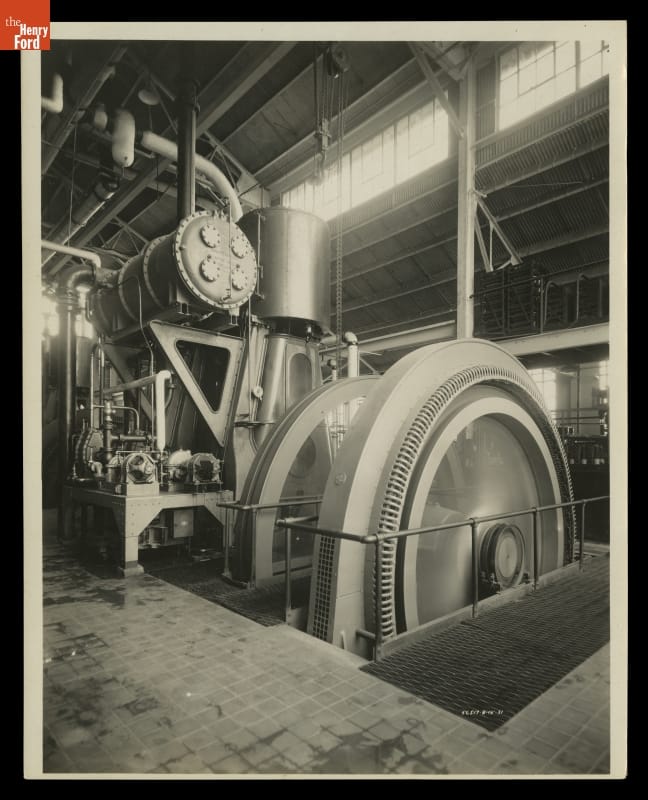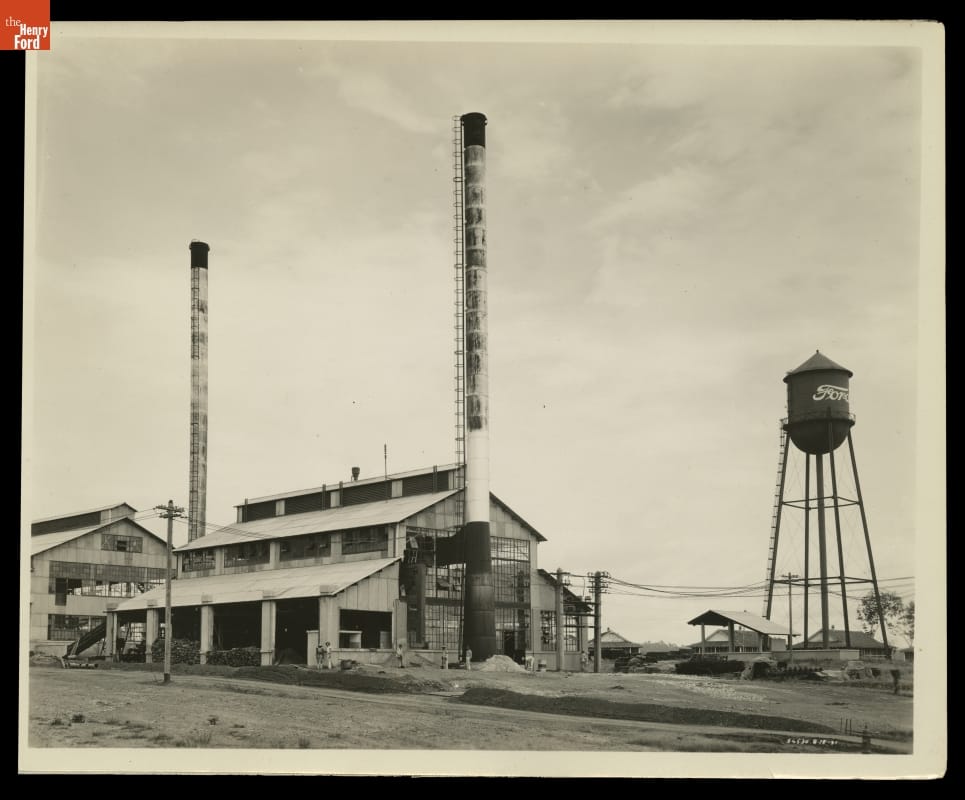Posts Tagged by kristen gallerneaux
The Walking Office
The Walking Office Wearable Computer is a visual prototype model that was created by the collaborative design group Salotto Dinamico in the mid-1980s. Salotto Dinamico, which translates to “dynamically, we grow,” was composed of Vincenzo Iavicoli, Paolo Bettini, Maria Luisa Rossi, Maurizio Pettini, and Letizia Schettini.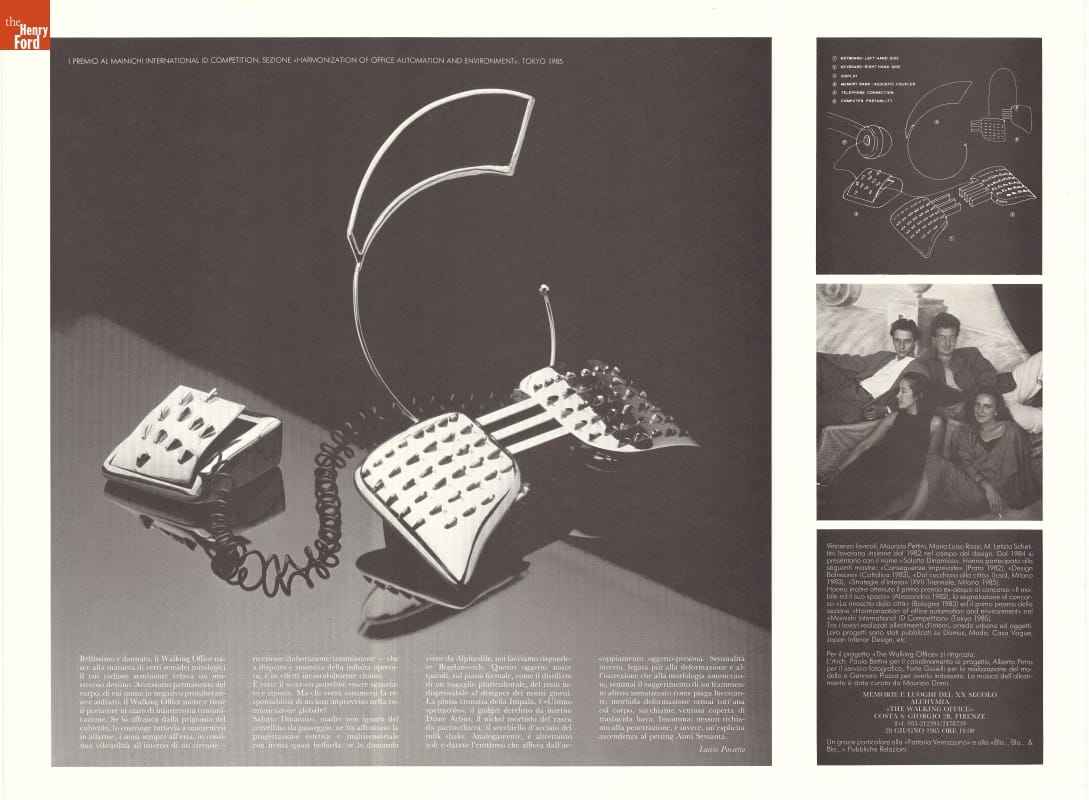 Image of poster advertising Salotta Dinamico’s “The Walking Office” THF291245
Image of poster advertising Salotta Dinamico’s “The Walking Office” THF291245
While all five members of the group had input in the project, Vincenzo Iavicoli submitted the concept as his 1983 undergraduate Industrial Design thesis at the ISIA school in Florence, Italy (under the guidance of his mentor, Paolo Bettini). The designers entered a physical model of the ideas in Iavicoli’s thesis in the 1985 Mainichi International Industrial Design Competition in Tokyo, Japan. The Walking Office won the top prize in the “Harmonization of Office Automation and Environment” category, attracting global attention in design, fashion, and technology publications. It was featured on the covers of Domus, ID, and Interni magazines, and received coverage in Brutus, Vogue, and approximately 70 other publications. The success of the project sparked the careers of the youngest members of the group, Iavicoli and Rossi, who formed their own successful design consultancy and became educators in Industrial Design programs around the world.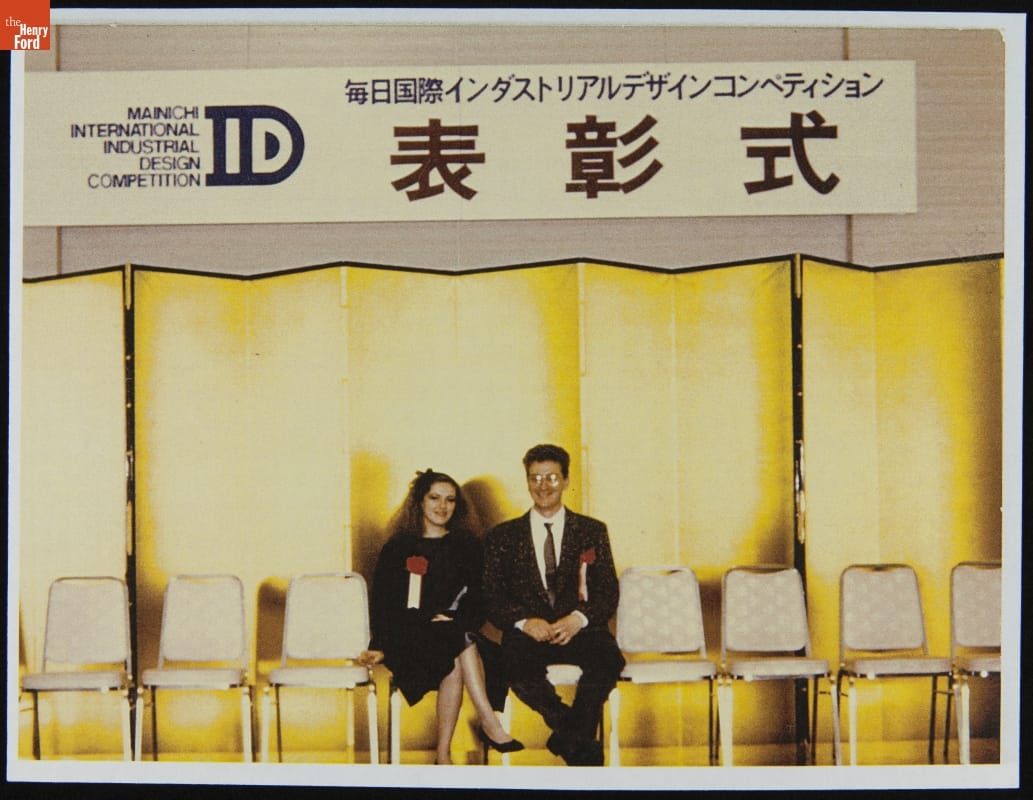
Designers Vincenzo Iavicoli and Maria Luisa Rossi at the 1985 Mainichi International Industrial Design Competition THF274743
The Walking Office model is made of polished chrome. Two pieces fit together to form a keyboard, the display arch fits into the keyboard to serve as a display, and a cassette recorder links up with an acoustic coupler modem to record and transmit data through any available telephone line. The Walking Office also doubles as personal adornment, with the keyboard pieces worn on the shoulder and the display arch as a headpiece (looking much like a mohawk). It combines the expressive aesthetic detail of 1980s Italian design with provocative high-tech materials to create an unapologetically cyberpunk-chic device. The Walking Office was not meant to be concealed (comparisons might be drawn between it and the Google Glass Explorer program of recent years), and its seductive styling was quite revolutionary in 1984. In a 2016 interview, Iavicoli recalled that though Japanese designers adeptly diffused new technologies into the mainstream, they had not yet begun to focus consistently on styling their devices. Early in the prototyping process, Iavicoli decided not to try to compete with the fast pace of technology, prioritizing strategy and concept instead.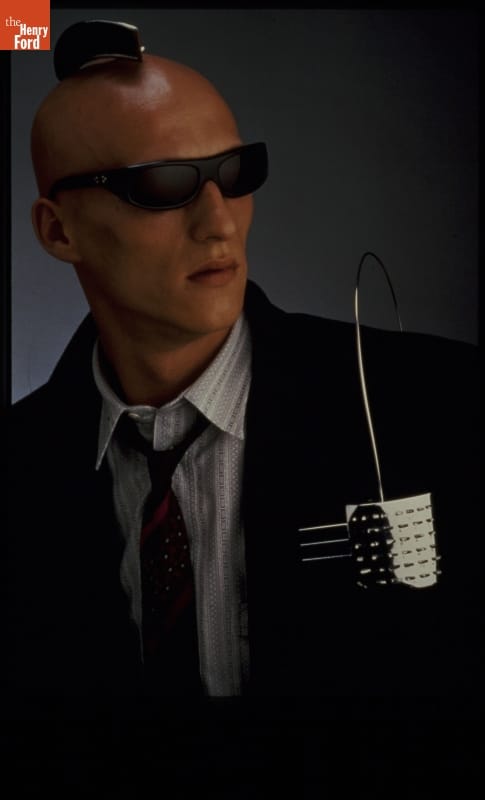
Model wearing “The Walking Office” prototype THF274747
Iavicoli’s thesis explored the design-thinking process behind the prototype: the history of physical office spaces (desks, lighting, cubicles, seating), the technology utilized within them (computers, calculators, modems, keyboards, online systems), and intangible aspects such as the psychology of work environments and spatial arrangements.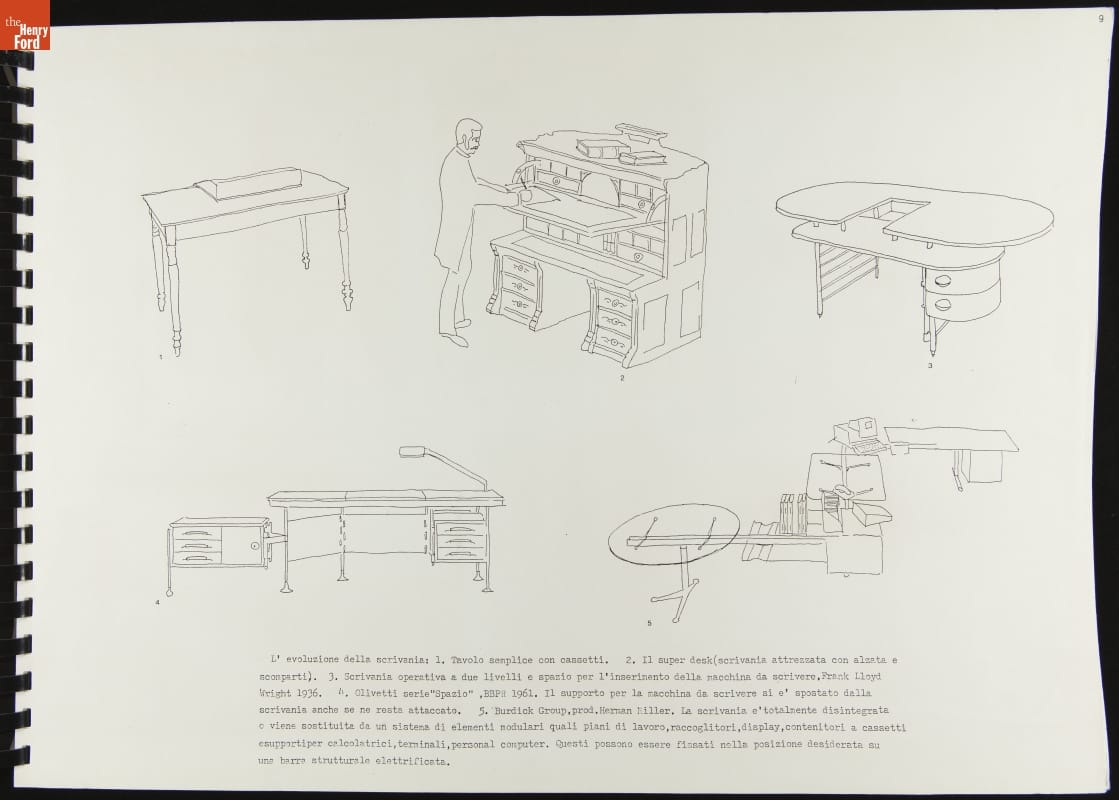
Page from Vincenzo Iavicoli’s undergraduate thesis THF275237
The designers of the Walking Office explored negative and positive elements of its proposed function. On one hand, they described it as “an Orwellian omen condemning portable work” (anticipating the desire of today’s knowledge workers to “unplug” themselves from the distractions of always-on technology.) A more positive spin situated the Walking Office as a route to freedom that would allow people to embrace the “amoral and amusing” aspects of creative work. They imagined “electronic machines…coming out of the office, conquering urban space, dwellings, golf courses, bars and beaches, becoming natural body accessories.”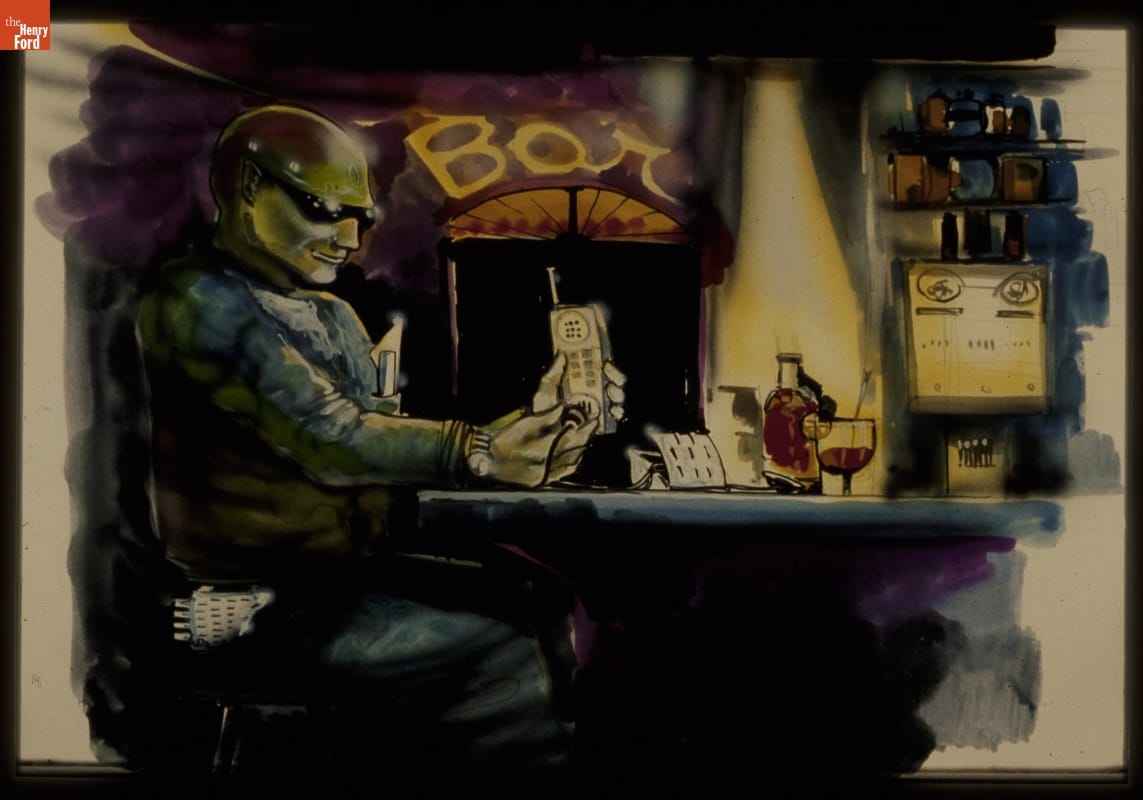
Drawing imagining “The Walking Office” in use THF274752
The Walking Office was pitched as a “techno-human” object. As a modern prosthetic, it subverted where (and when) the office could be, essentially turning the human body into a mobile workstation. It proposed the same type of fluid interactions with technology as one would have with pens, watches, and eyeglasses. And finally, it provided an alternative method of accessing and using information in an efficient way.
Kristen Gallerneaux is Curator of Communications and Information Technology.
20th century, 1980s, Europe, technology, portability, design, computers, by Kristen Gallerneaux
Robert Propst: Unorthodox Thinker
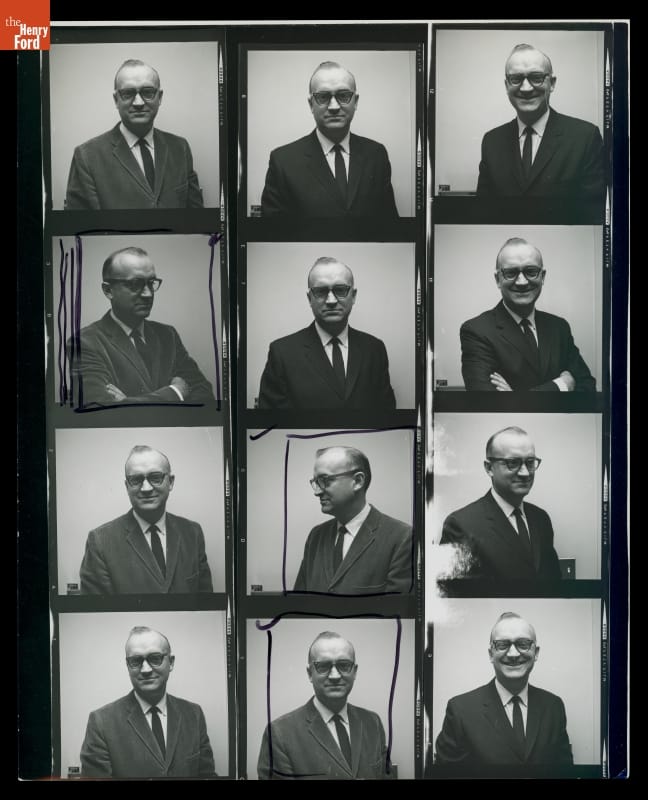 Portraits of Robert Propst. THF137271
Portraits of Robert Propst. THF137271
PROFESSION: Designer (Although he preferred to be called "searcher")
INNOVATION: The Action Office II System (1968) and the movable "coherent structures” of the Co/Struc System designed for hospitals (1971)
ATTRIBUTES: Empathetic observer, serial problem solver, unorthodox thinker
You could be forgiven if you aren’t familiar with the work of Robert Propst. After all, if his designs were working as he intended, they simply disappeared.
Propst became director of the Herman Miller Research Division (HMRD) in 1960, setting up shop in a small concrete building in Ann Arbor, Mich. The founder of Herman Miller, D.J. DePree, saw potential in Propst’s ambitious thinking and hired him to broaden the company’s product range. Very few guidelines were in place at HMRD: Nothing should be connected to military use, no furniture designs — and whatever was designed should simply “be useful.”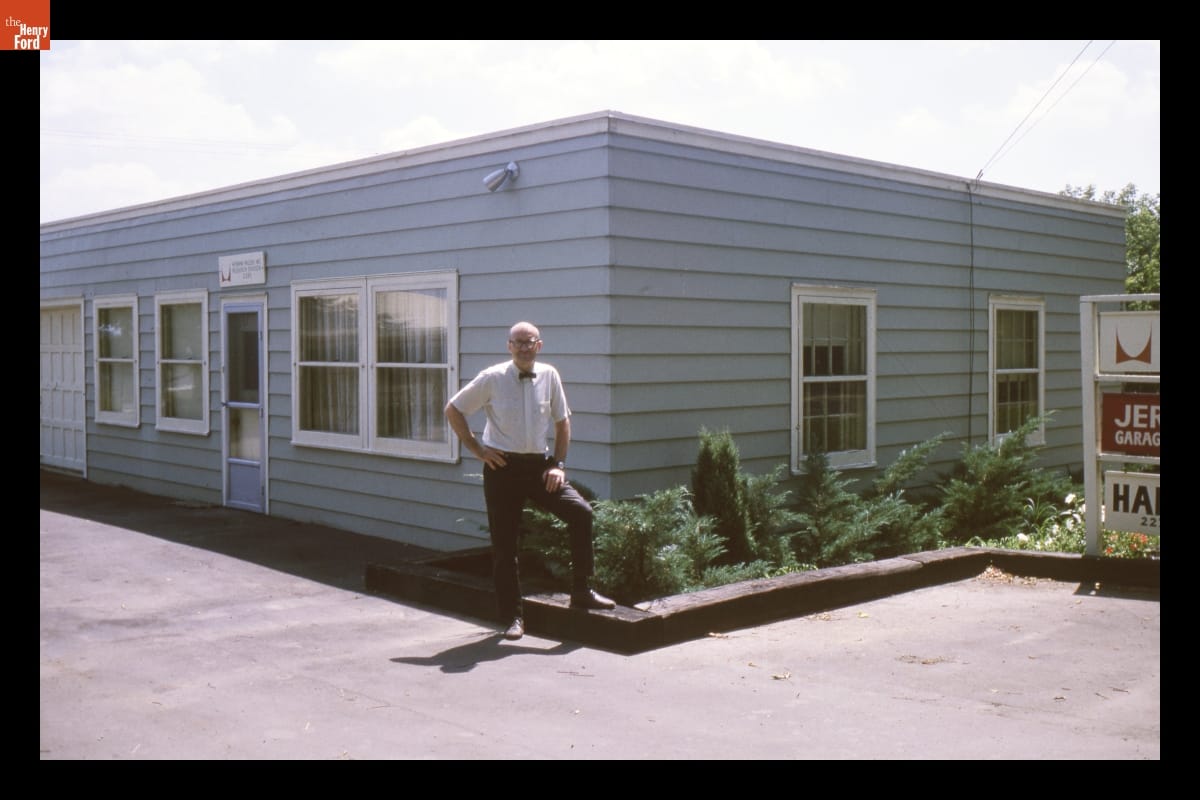 Robert Propst Outside Herman Miller Research Division Office, Ann Arbor, Michigan, July 1964. THF137214
Robert Propst Outside Herman Miller Research Division Office, Ann Arbor, Michigan, July 1964. THF137214
Deliberately choosing a building more than 150 miles away from Herman Miller’s headquarters in Zeeland, Mich., Propst exercised his freedom to research without the distraction of corporate meetings. For every idea he had that went into production, hundreds more were filed away.
Two of Propst’s most impactful projects were holistic environments designed for high-impact workplaces: the improved Action Office II system (1968) and the movable “coherent structures” of the Co/Struc system designed for hospitals (1971).
In Propst’s mind, offices had become chaotic wastelands. Cobbled together furniture, nonergonomic chairs and an invasion of technology onto ad hoc surfaces. Action Office — a modular system of free standing panel walls — could be fluidly arranged into nooks for working, conference areas and other purpose-driven needs. An idealistic vision for the birth of the modern office cubicle.
Propst wasn’t always a designer of “things” but of situations. He attacked issues from the reverse, finding clues in the algorithms of human behavior working in high-stakes spaces. How did people move while working? Where was time being spent? Wasted? How can we support safety? Privacy? Collaboration? The physical solutions he engineered encouraged ideas of access, mobility and efficiency. His modular approach to office landscapes was intended to have a 1 + 1 = 3 effect. Which is to say that by implementing physical change, “knowledge” workers could then springboard off an improved relationship with their workspaces, which were suddenly more hospitable to launching new ideas, productive workflows and transformative projects.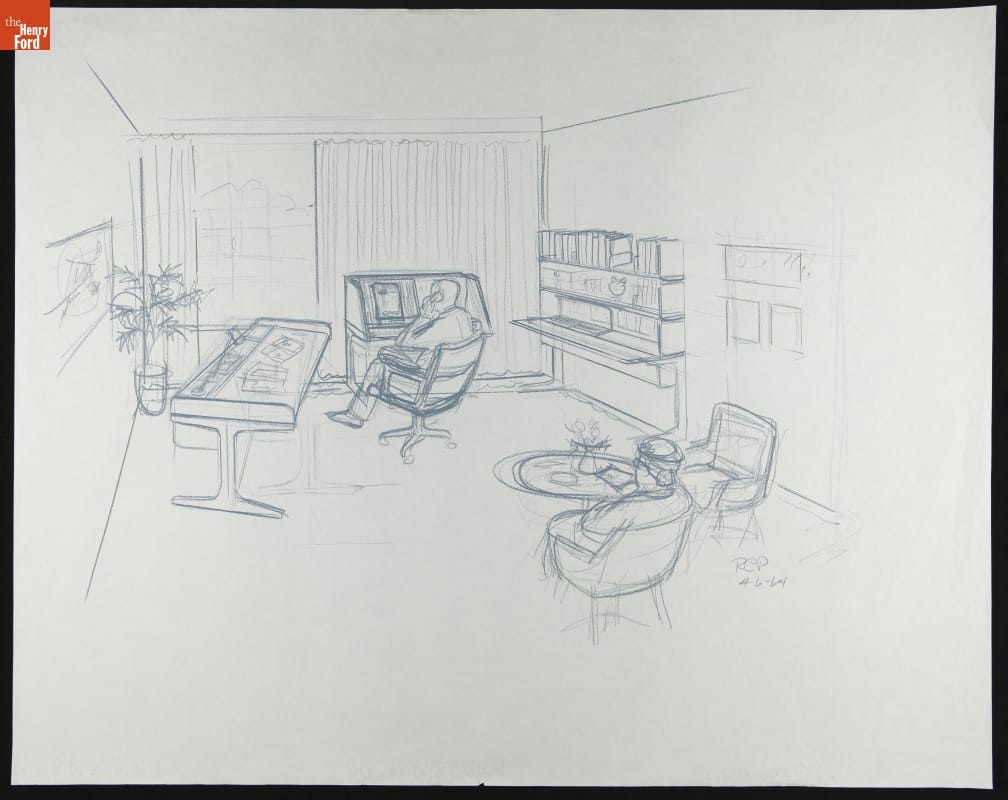 Action Office Project Drawing by Robert Propst, April 6, 1964. THF241708
Action Office Project Drawing by Robert Propst, April 6, 1964. THF241708
Did You Know
- The proliferation of the office cubicle is almost single-handedly due to the introduction of the Action Office II system in 1968. Unfortunately, the mobile aspect of Action Office became rooted to the floor, quite literally. Large businesses filled their buildings with Action Office (or its various knock-offs) to create Dilbertesque “cubicle farms.”
- The first version of Action Office was conceived by Robert Propst and designed by George Nelson in 1964, but sales were lackluster. Corporate managers worried about the porous borders being offered to their staff, now called “knowledge workers,” and the cost was simply too high. Propst returned to the drawing board alone for AO2.
- Robert Propst did not like to be referred to as a designer. He also didn’t like the term “researcher,” because it implied looking backward. His ideal description for his activities was “searcher.”
Kristen Gallerneaux is Curator of Curator of Communication & Information Technology at The Henry Ford. This post was adapted from an article in the January-May 2019 issue of The Henry Ford Magazine.
Herman Miller, The Henry Ford Magazine, by Kristen Gallerneaux, Robert Propst, furnishings, design
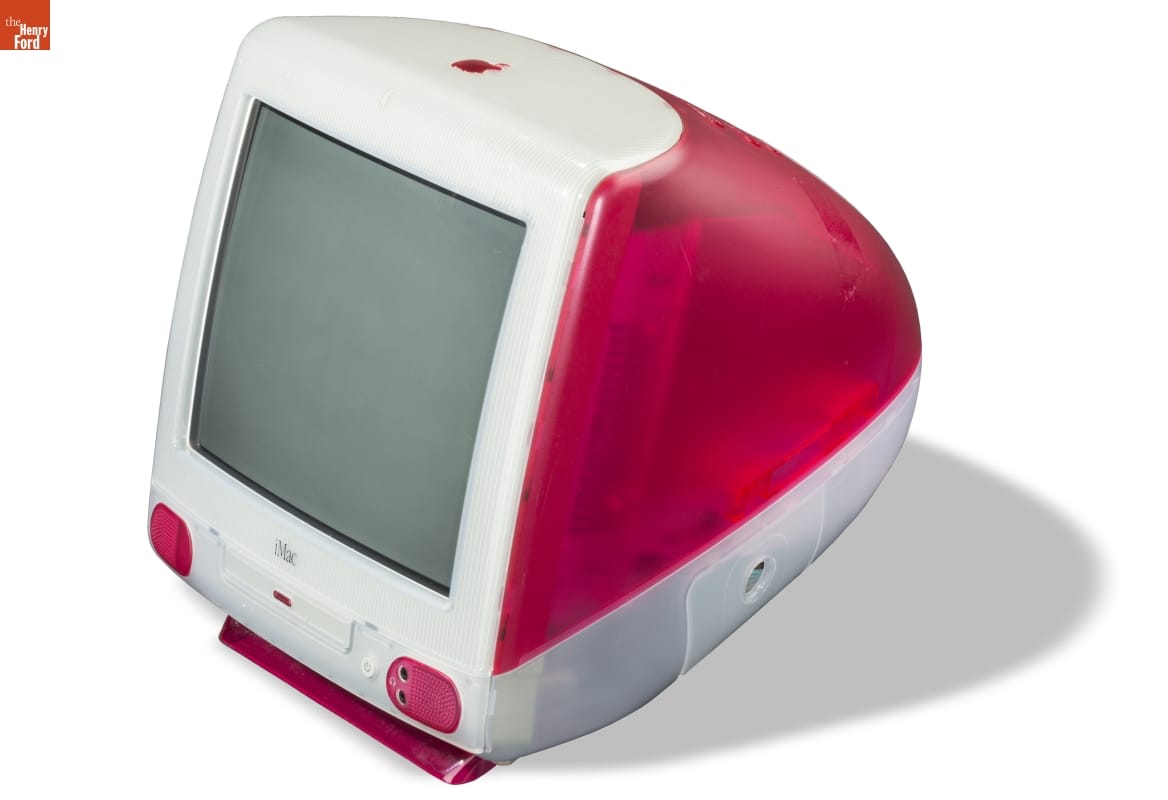
In the 1980s, desktop computers emphasized non-committal, neutral shades: beige, off-white, black, and the just-barely-greys of putty and fog. During a time when popular culture included the flashiness of MTV, new wave music pressed onto colorful records, and hip hop culture--why so much beige?
Truthfully, home computers were becoming more common, but the largest market remained in office environments. Neutral computers provided visual unity among cubicles, and masked aging plastic.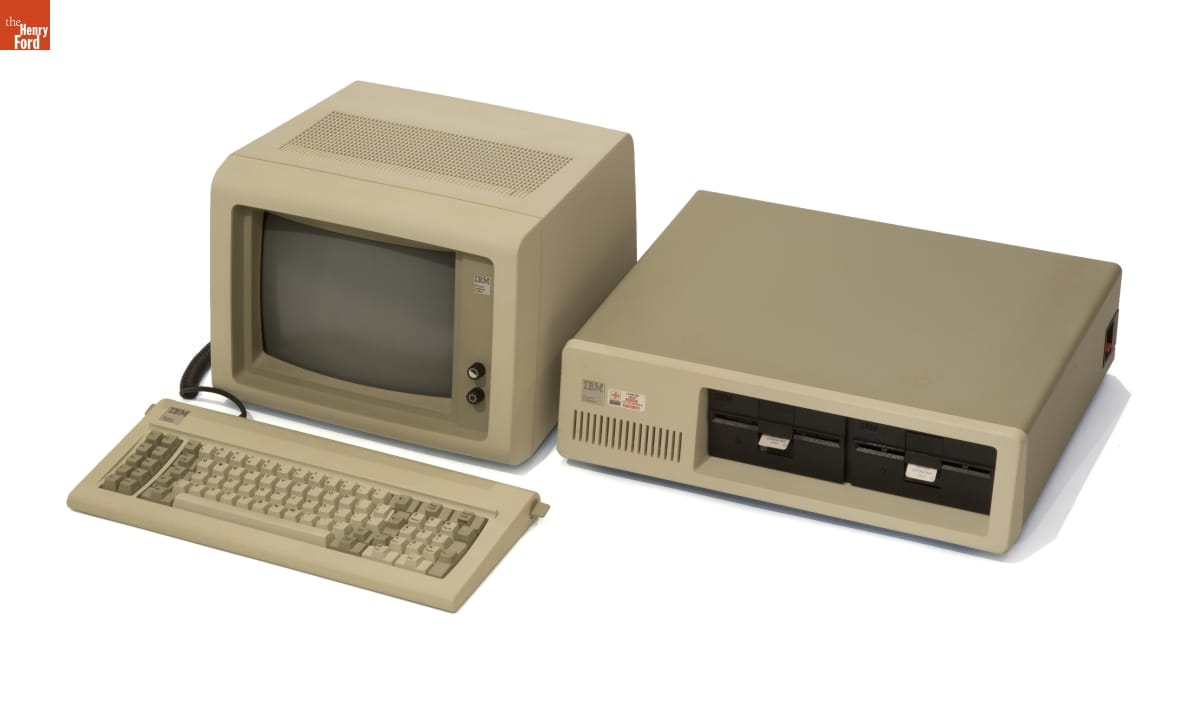
IBM Personal Computer, Model 5150, 1984. THF156040
The Apple Newton eMate was one of the first personal computers to break away from the typical form of the "opaque beige box."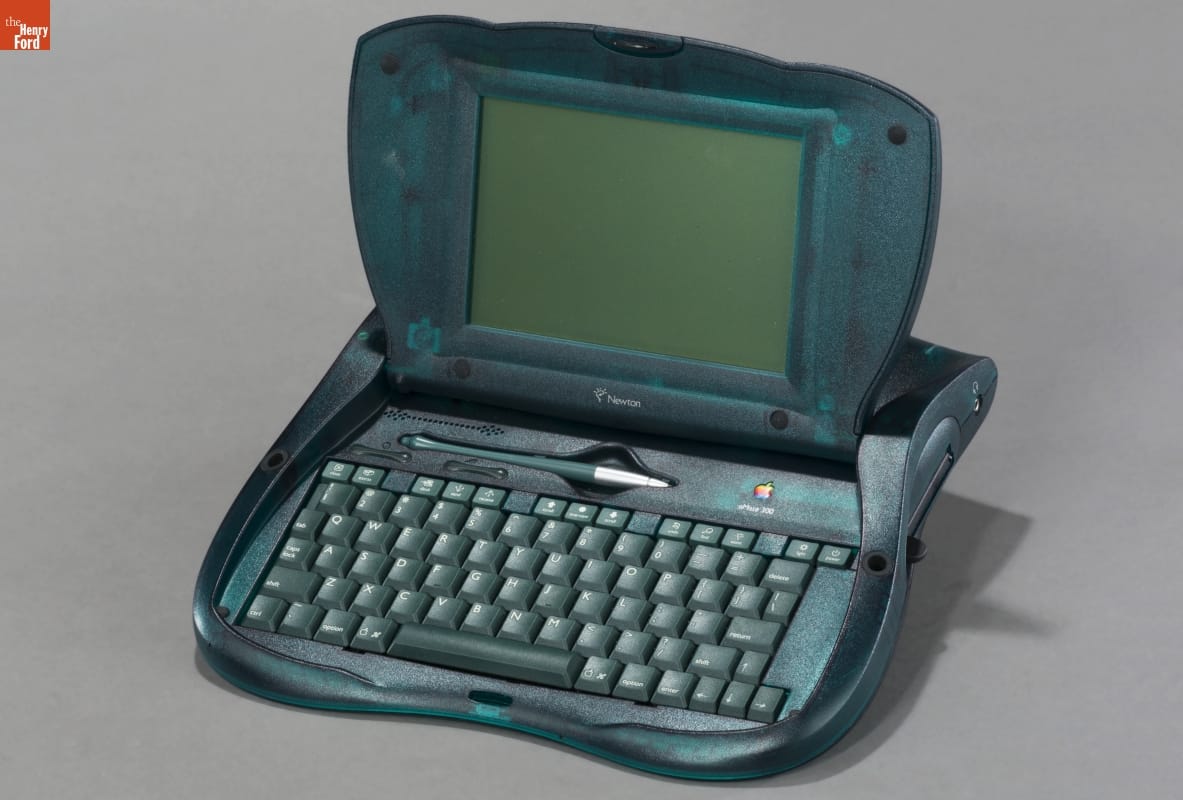
Apple eMate 300, 1997. THF172045
The eMate's distinctive translucency was soon echoed by Jonathan Ive in his radical case design for the iMac G3 computer. From 1998-2001, the iMac was available in an array of 13 colors--from Bondi Blue to Flower Power. 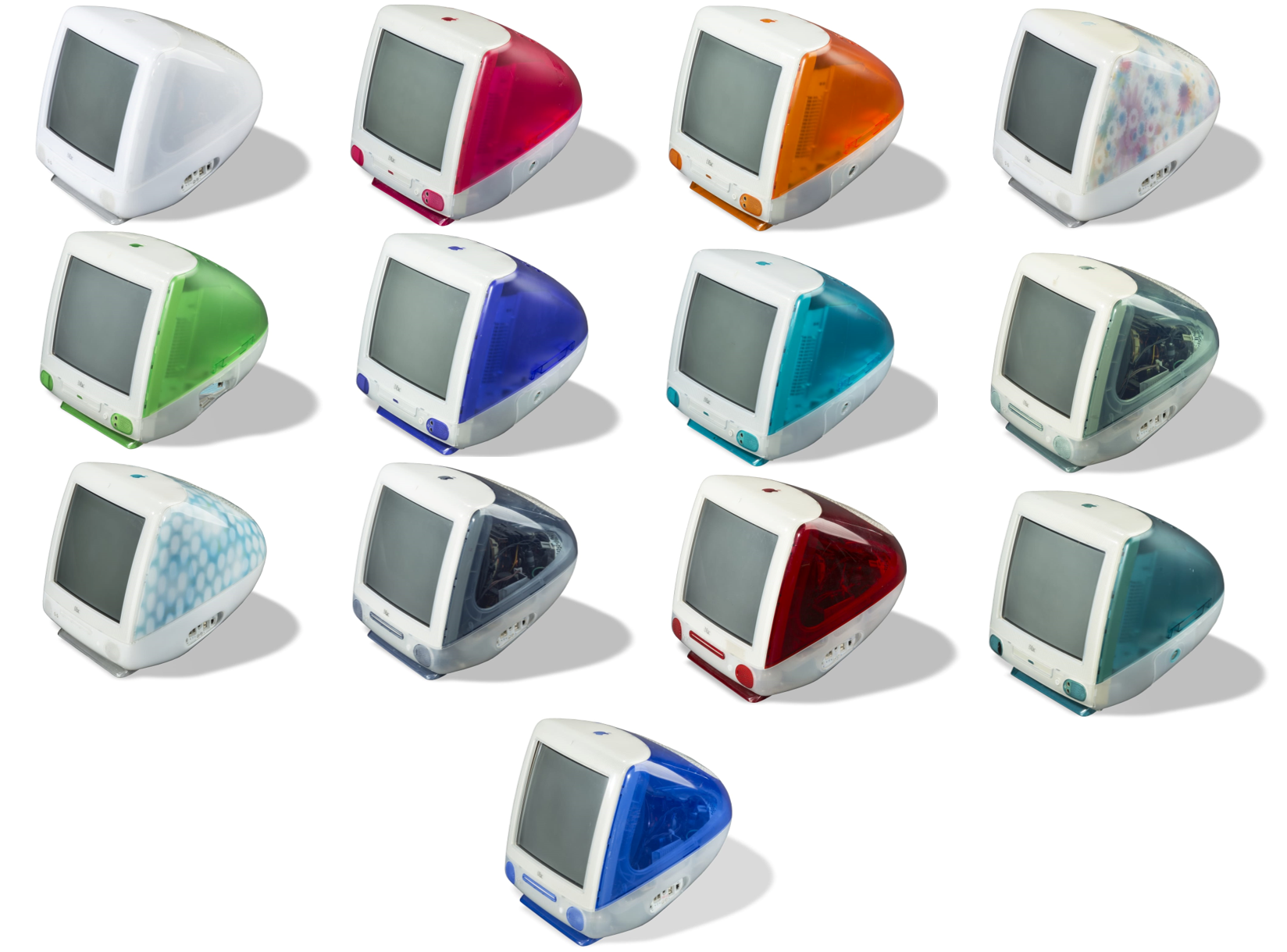
View all 13 colors of the Apple iMac in The Henry Ford’s digital collections.
This post features objects and text displayed in the 2018 pop-up exhibition Looking Through Things: Transparent Tech, Fashion, and Systems at Henry Ford Museum of American Innovation.
Kristen Gallerneaux is Curator of Communication & Information Technology at The Henry Ford.
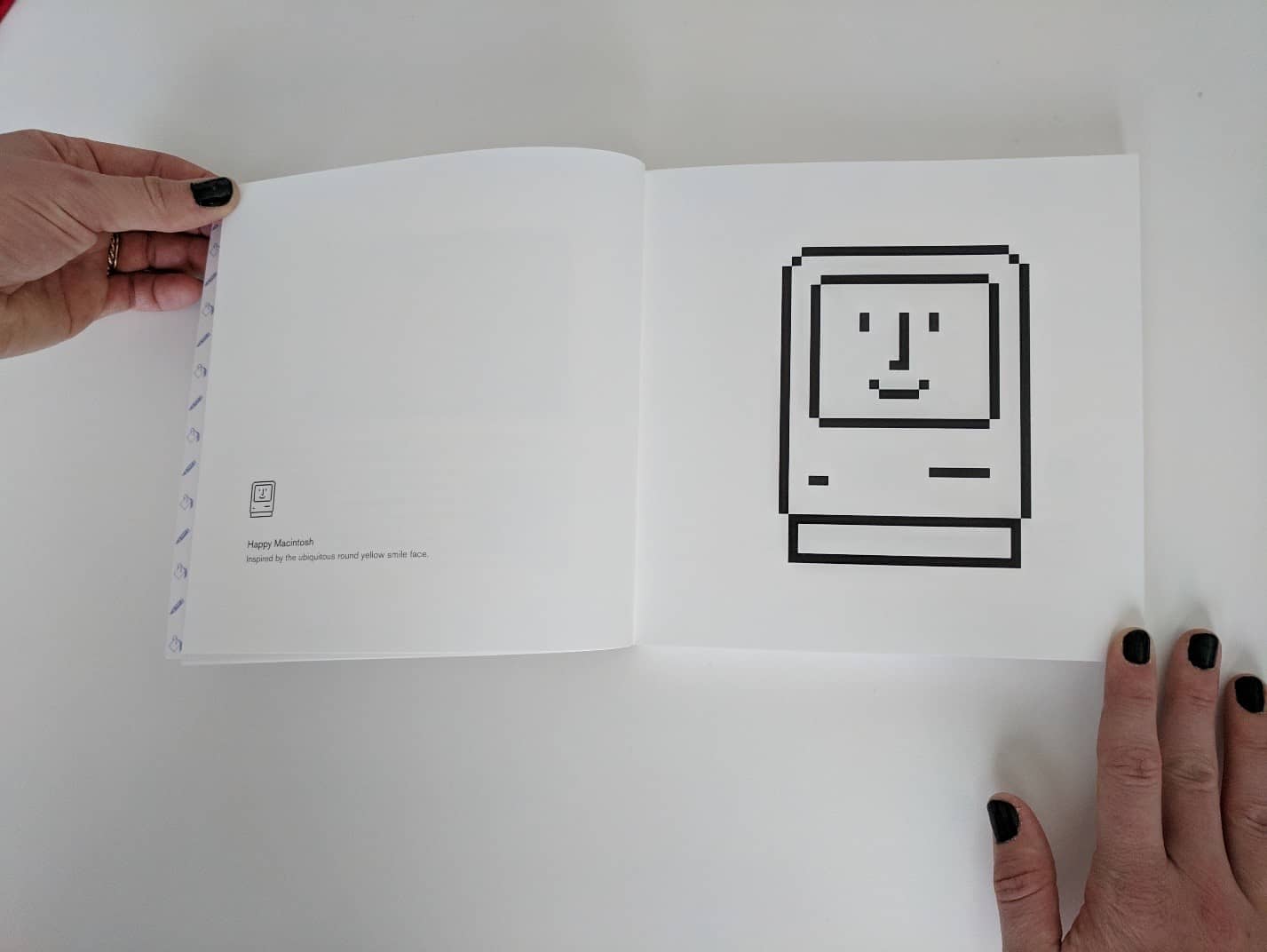
"Happy Macintosh" icon from the book, Icons: Selected Work from 1983-2011, available at the Benson Ford Research Center.
It’s 1984. Turn on your Macintosh computer. Marvel at the convenience of the mouse under your hand. Point the arrow on your screen towards a desktop folder and click to open a file. Drag it and drop it somewhere else. Or, open some software. How about MacPaint? Select the pencil, draw some craggy lines; use the spilling paint bucket to fill in a shape. Move your arrow to the floppy disk to save your work. And then… imagine a worst-case scenario, as the ticking wristwatch times out. A pixelated cartoon bomb with a lit fuse appears. Your system crashes. The “sad Mac” appears.
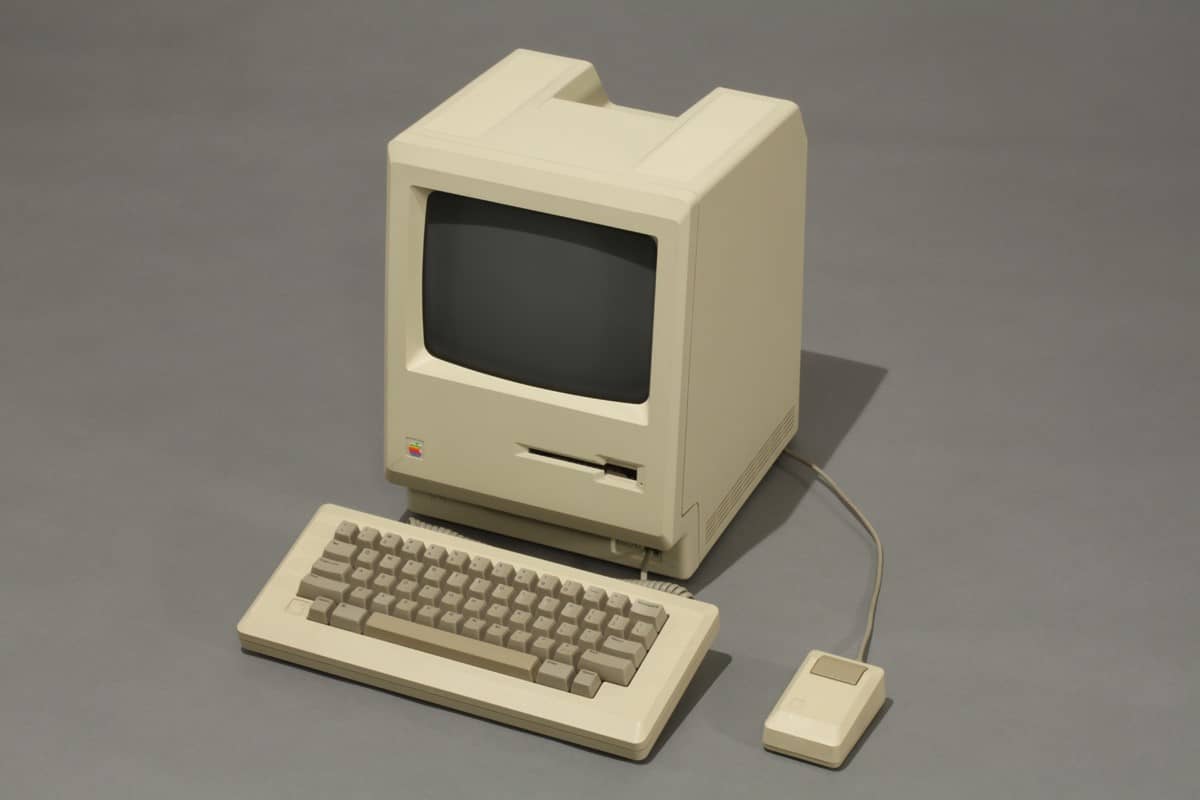
The Macintosh Personal Computer introduced Susan Kare’s icons to the world in 1984.
Introducing the Icon
Computer icons are visual prompts that when clicked on, launch programs and files, trigger actions, or indicate a process in motion. Clicking an icon is a simple gesture that we take for granted. In our current screen-based culture—spread between computers and smartphones—we might absent-mindedly use these navigational shortcuts hundreds (if not thousands) of times a day.
Before the mid-1980s, after booting up their computers, people typically found themselves greeted by a command line prompt floating in a black void, waiting for direction. That blinking cursor could seem intimidating for new home computer users because it assumed you knew the answers—that you had memorized the machine’s coded language. The GUI (graphical user interface, pronounced “gooey”) changed how humans interacted with computers by creating a virtual space filled with clickable graphical icons. This user-centric form of interaction, known as “the desktop metaphor,” continues to dominate how we use computers today.
The 1984 Apple Macintosh was not the first computer to use a GUI environment or icons. That achievement belongs to the 1973 Xerox Alto—a tremendously expensive, vertically-screened system that only sold a few hundred units. After a few failed attempts, the multi-tasking GUI system finally found a foothold in the home computing market with the introduction of “the computer for the rest of us”—the Macintosh.
From Graph Paper to Screen Pixels
After completing her PhD in Art History, Susan Kare briefly entered the curatorial sphere before realizing that she would rather dedicate her career to the production of her own creative work. In 1982, Andy Hertzfeld, a friend of Kare’s from high school, called with an interesting opportunity: join Apple Computer’s software group and help design the user experience for the then-developing Macintosh computer. 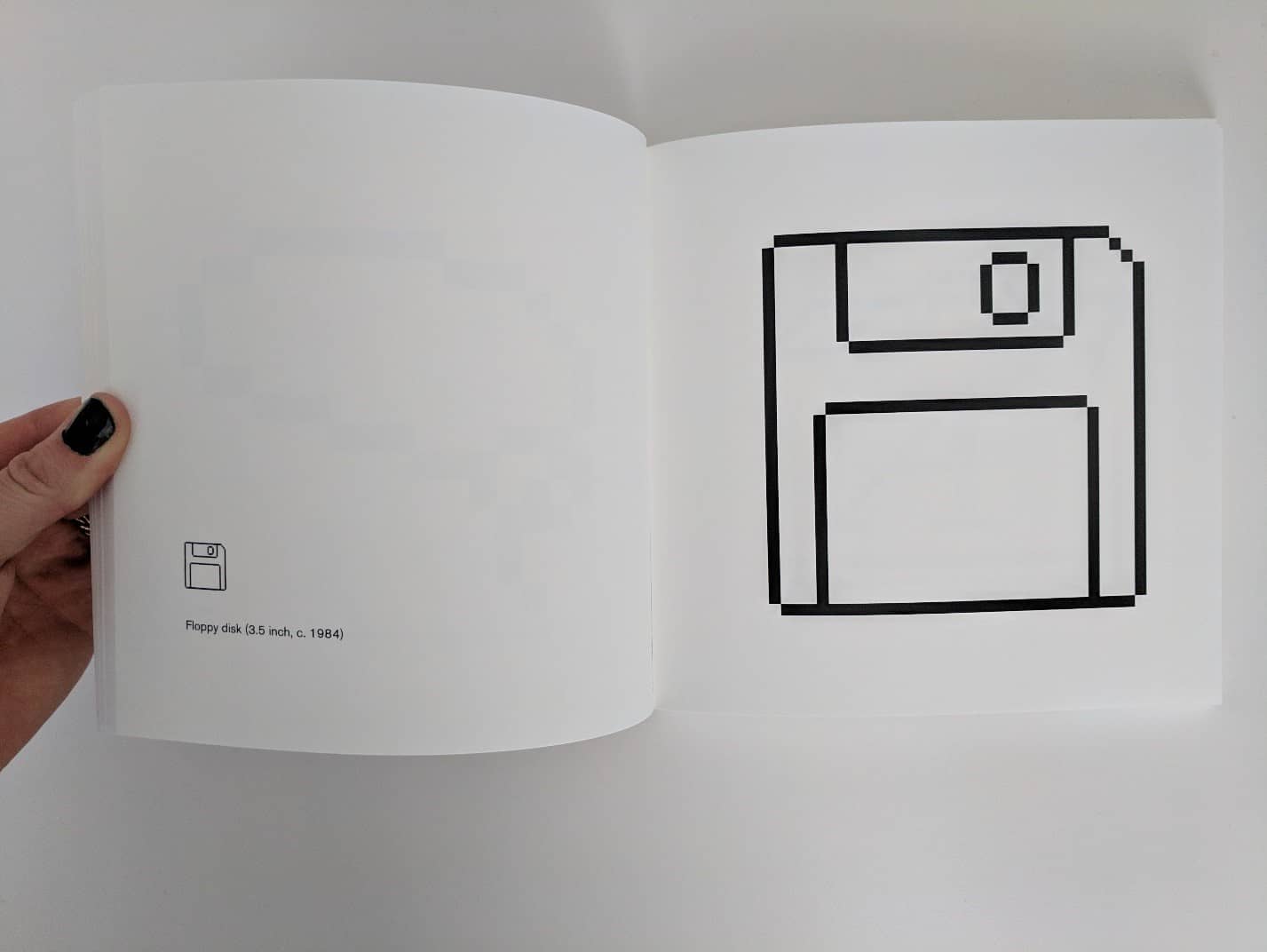
“Floppy Disk” save icon from the book, Icons: Selected Work from 1983-2011, available at the Benson Ford Research Center.
Kare took up Hertzfeld’s offer and set to work designing the original Macintosh icons, among them the trash can, the file folder, the save disk, the printer, the cloverleaf command (even today, this symbol appears on Apple keyboards), and the mysterious “Clarus the Dogcow.”
Since no illustration software existed yet, Kare designed the first Macintosh icons and digital fonts through completely analog means. Using a graph paper notebook, she filled in the squares with pencil and felt-tipped pens, coloring inside the lines of the graph as an approximation of the Macintosh’s screen. Despite the limitation of available pixels, Kare found economical ways to provide the maximum amount of visual or metaphoric meaning within a tiny grid of space—all without using shading or color.
Next Wave
Kare’s icons and digital fonts exist beyond the lifespan of the Macintosh, appearing in later Apple products and even early iPods. Iterations and mutations of her icon designs continue to define the visual shorthand of our desktops and software today, migrating across systems and platforms: NeXT Computers, IBM and Windows PCs. Have you ever played Solitaire on a Windows 3.0 computer? If so, you’ve played with Kare’s digital deck of cards.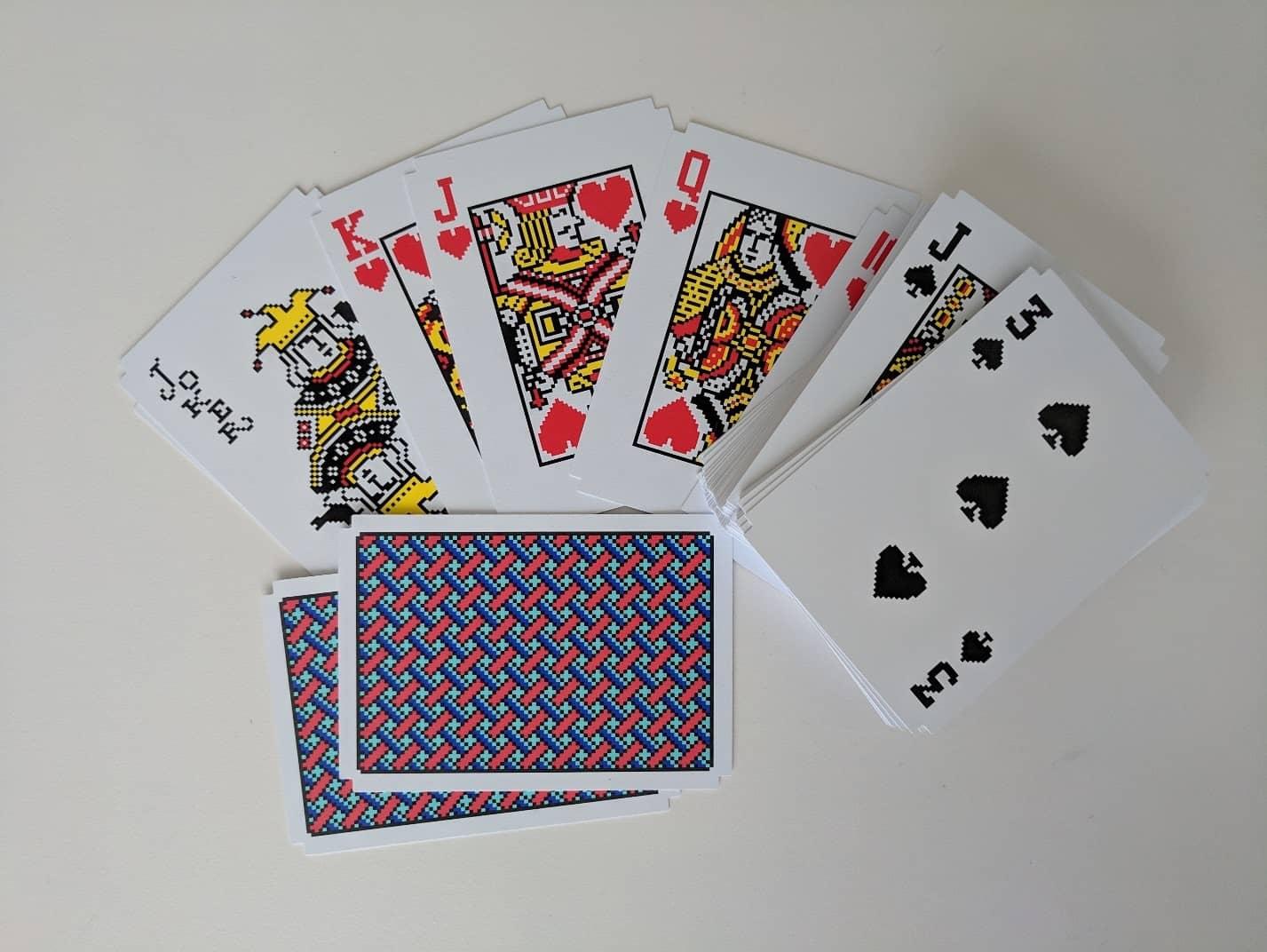
A physical version of Susan Kare’s Windows 3.0 Solitaire game.
Have you ever sent a “virtual gift” over Facebook like a disco ball, penguin, or kiss mark? Again, this is the work of Kare, whose work has been quietly shaping our interactions with technology since 1984—making computers seem more friendly, more human, more convenient—one click at a time. 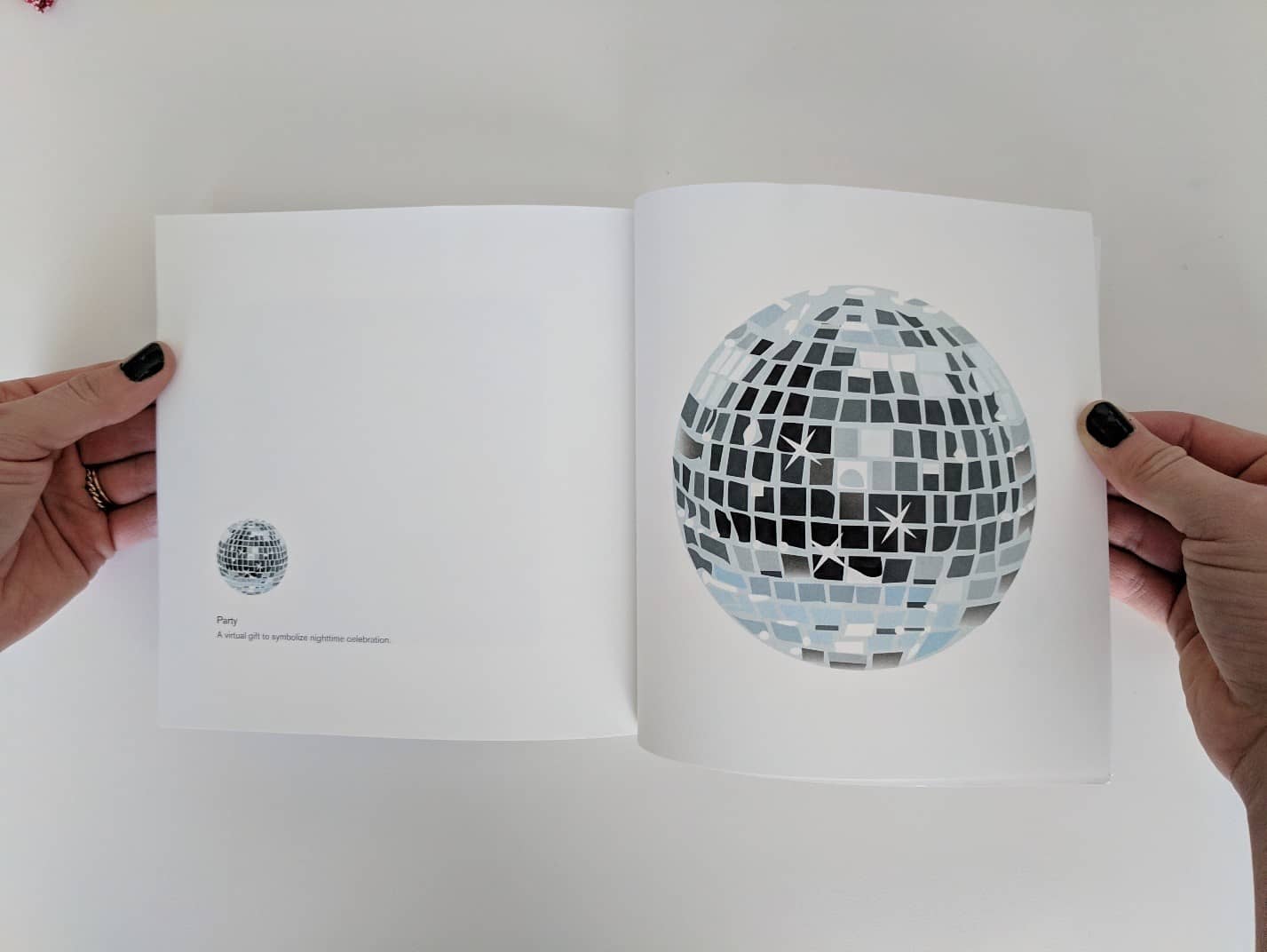
Disco ball “party” icon from the book, Icons: Selected Work from 1983-2011, available at the Benson Ford Research Center. Kare-designed bandana and tea towels woven on a Jacquard loom.
Kare-designed bandana and tea towels woven on a Jacquard loom.
Kristen Gallerneaux is Curator of Communications & Information Technology at The Henry Ford.
communication, design, by Kristen Gallerneaux, technology, computers, women's history
Celebrating Women at Atari
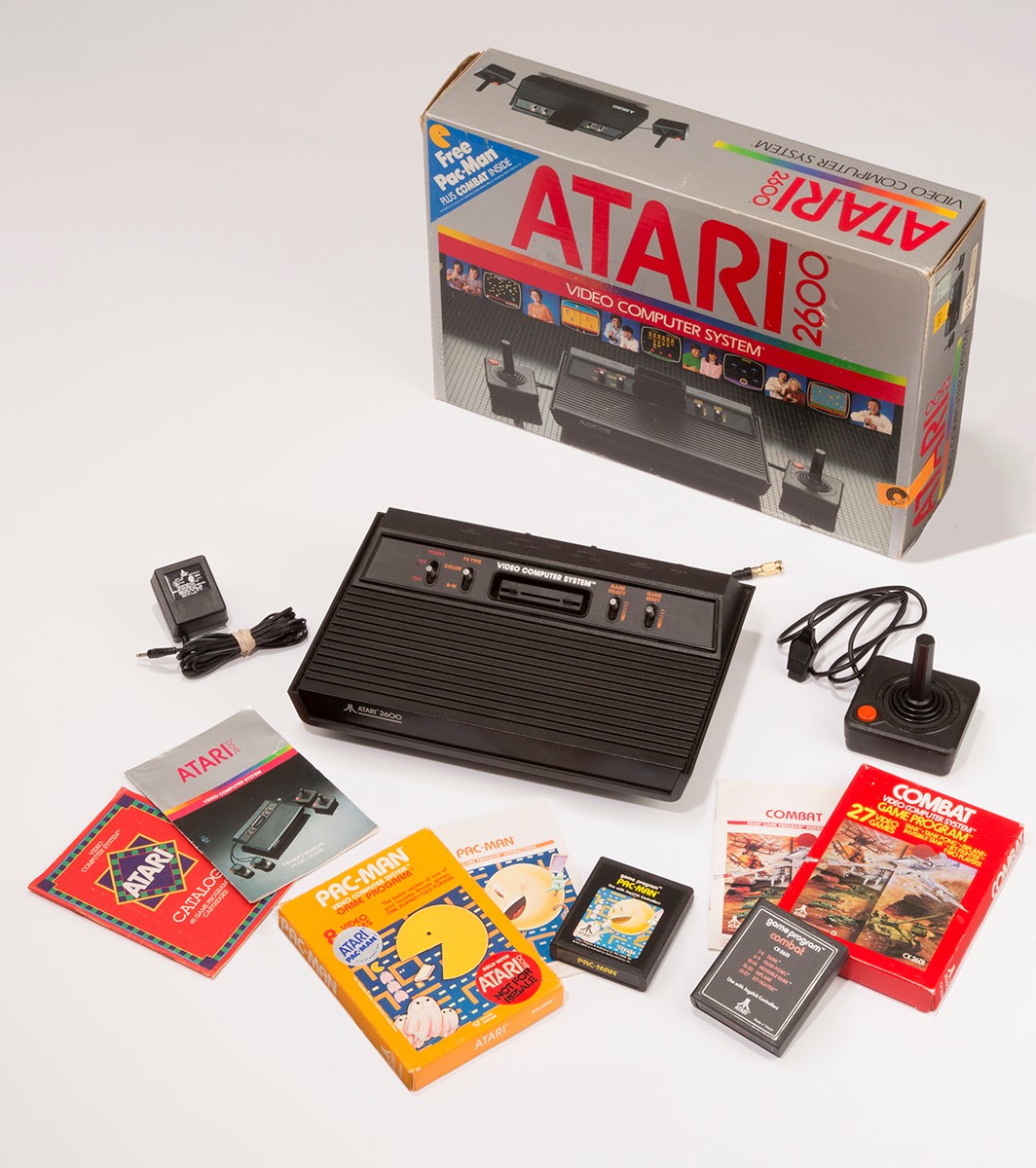
The familiar silver packaging for the “Black Vader” Atari 2600 was created by Evelyn Seto, who led the Atari design team with John Hayashi. THF160364
Cardboard boxes printed in bold colors: shimmering silver, blazing orange, primary blue, circus purple—hot pink. Overlaid with white and yellow Bauhaus typography announcing the contents: Centipede, Breakout, Space Invaders. Inside the box, a black plastic cartridge that holds the promise of video game entertainment, all from the comfort of home. Games played while sitting cross-legged on the floor. Later, aching hands from hours of play on a square, non-ergonomic, one-button joystick. No quarters necessary. By the fall of 1977, there was no denying the fact that the arcade was successfully finding its way into the living room.
The Atari Video Computer System (later sold as the Atari 2600) changed the gaming industry. Earlier systems like the Magnavox Odyssey, Home PONG, and the Fairchild System F were available in the early 1970s, but the remarkable success of the Atari 2600 defined a “second generation” of home consoles, selling over 30 million units between 1977 and 1992.
The number of games available for the 2600—taking into account Atari and Sears releases as well as those by third-parties like Activision and Imagic—finds us looking at approximately 550 unique titles. Several games within this vast library include important contributions made by women.
Female employees were not uncommon at the company. Carol Kantor became the first market researcher at a video game company, ever. Wanda Hill drew the circuit diagrams for Asteroids. Judy Richter worked as a packaging designer and production manager for a decade, through multiple leadership transitions. The people working on the assembly lines populating the circuit boards for arcade games were almost all women. Evelyn Seto supervised the design team, inking the original three-pronged “Mt. Fuji” logo and creating the shelf-appealing silver packaging for the Atari 2600.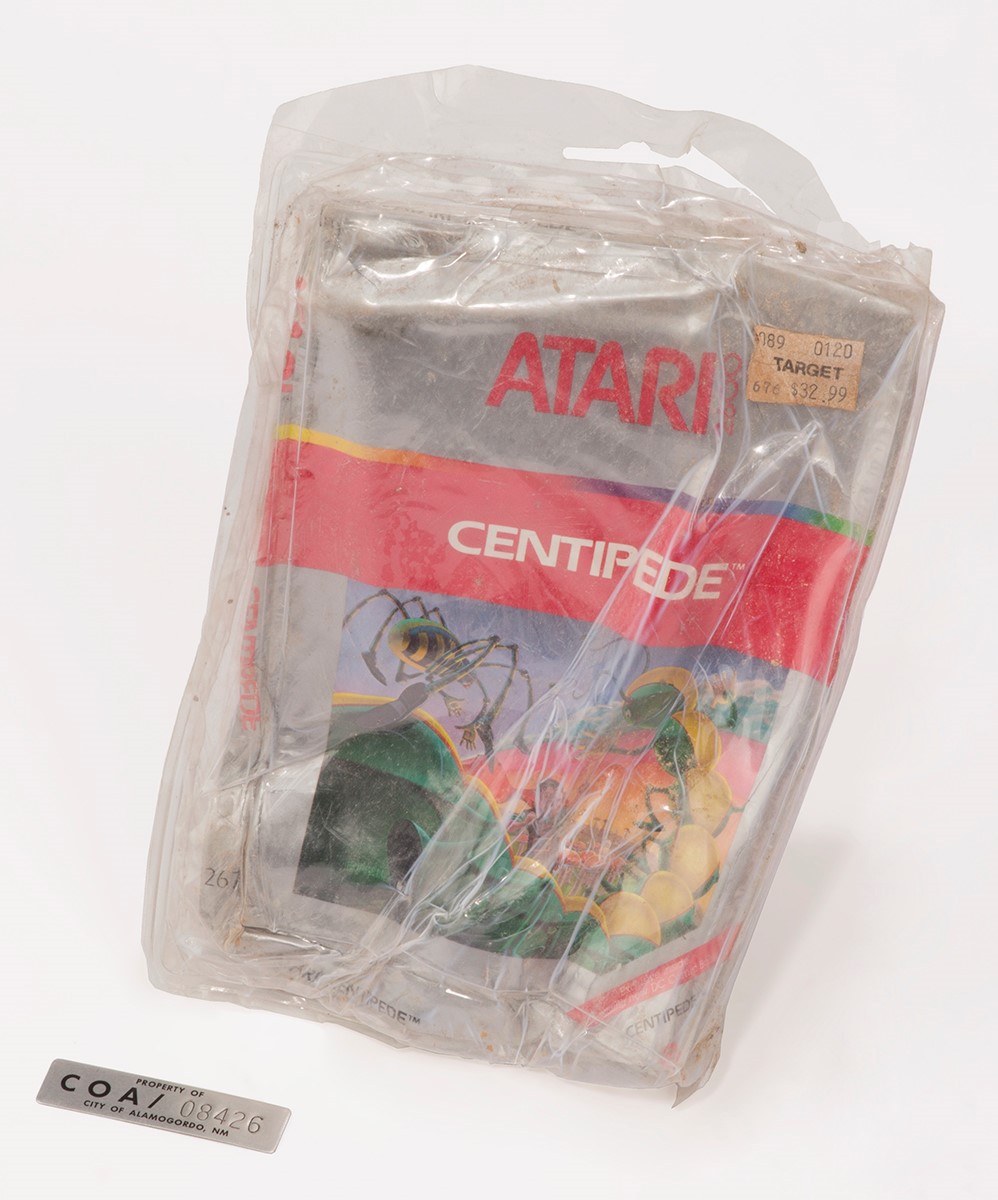 Dona Bailey and Ed Logg’s 1980 arcade version of Centipede was translated as a “port” for the Atari 2600 in 1982. In 2013, this cartridge was excavated from the “Atari Tomb” located in an Alamogordo, New Mexico landfill. THF159973
Dona Bailey and Ed Logg’s 1980 arcade version of Centipede was translated as a “port” for the Atari 2600 in 1982. In 2013, this cartridge was excavated from the “Atari Tomb” located in an Alamogordo, New Mexico landfill. THF159973
The scales were not exactly balanced in terms of gender equality within Atari’s engineering staff, but take for instance the work of Dona Bailey, programmer of the arcade version of Centipede (1980). Not only was she the first female programmer to design an arcade game, but her collaboration with Ed Logg led to the creation of one of the most iconic video games of all time.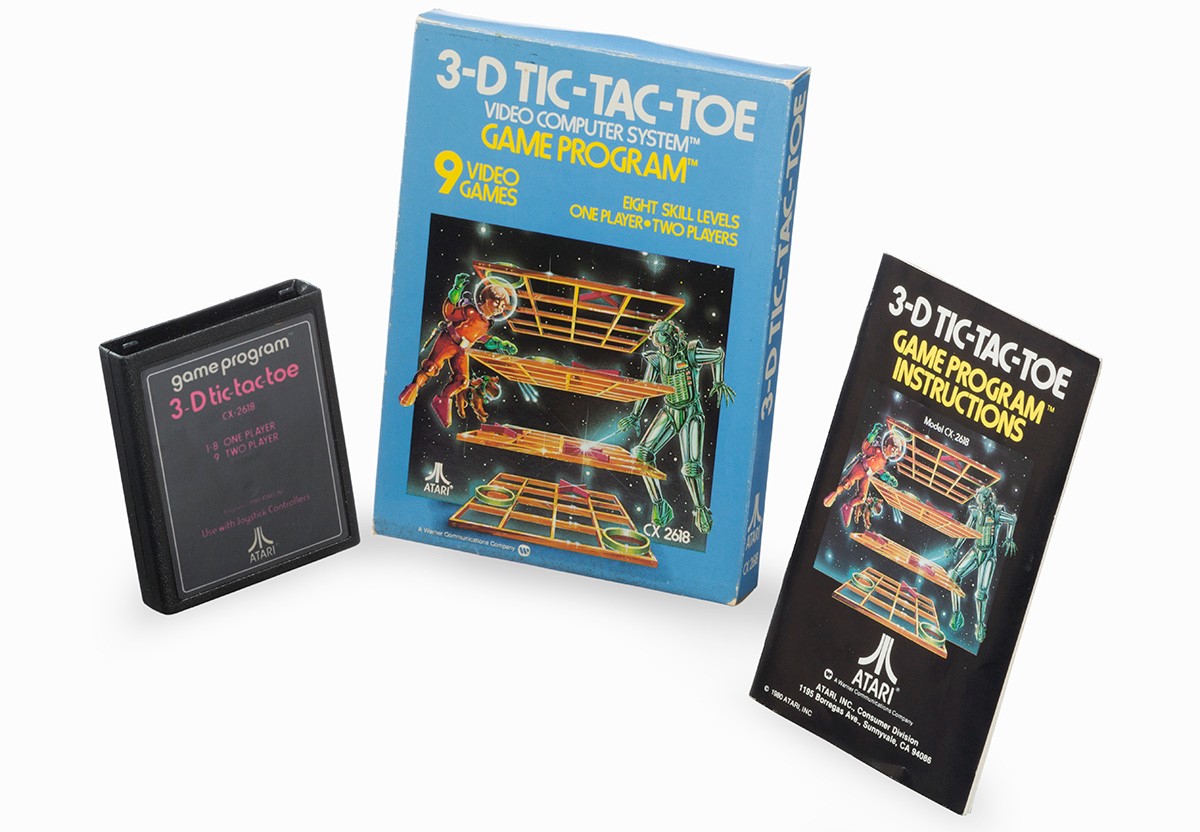
When Carol Shaw created 3D Tic-Tac-Toe, she became the first professional female video game developer. THF171081
Carol Shaw & Susan Jaekel
Dona Bailey’s time in the “coin-op” division at Atari overlapped with Carol Shaw’s work for the “cart” division. In 1977, Shaw graduated from the University of California, Berkeley’s Computer Science program, and was hired as the first female programmer at Atari in August 1978. When she completed her first cartridge game that year—3D Tic-Tac-Toe—she effectively became one of the women to work in the professional video game industry. 3D Tic-Tac-Toe is an abstract strategy video game based on a game called Qubic, which was originally played on room-sized computers in the mid-1950s.
In the 1970s and 80s, the exterior graphics of a coin-op console or the illustration on a game’s cardboard box were often a player’s first exposure to a game. Typically, the vibrant and dynamic graphics promoting a game were light years beyond the pixelated game that showed up on the screen. Nonetheless, Evelyn Seto from Atari’s graphics team once said: “The romance of the game was told in the box artwork.”
And what could be more intriguing than a woman in space with her spacesuit-clad dog competing against a robot with laser-powers? The illustrations on 3D Tic-Tac-Toe’s box were painted by Susan Jaekel, who became known for her illustrated textbooks and cookbooks, as well as the packaging for Atari’s Adventure, Circus, Basic Math, and others. On 3D Tic-Tac-Toe, Jaekel collaborated with Rick Guidice to create the four grids in the design; Guidice is well-known for his 1970s illustrations of space colonies for NASA’s Ames Research Center.
In 1978, Shaw also programmed Video Checkers and Super Breakout (with Nick Turner). In 1982, Shaw left Atari to work for Activision, where she created her most celebrated game: River Raid. River Raid by Carol Shaw. Activision was the first third-party video game developer, making compatible cartridges for the Atari 2600. THF171080
River Raid by Carol Shaw. Activision was the first third-party video game developer, making compatible cartridges for the Atari 2600. THF171080
River Raid is a top-down-view scrolling shooter video game. Players move a fighter jet left to right to avoid other vehicles, shoot military vehicles, and must refuel their plane to avoid crashing. The game was pioneering for its variation in background landscape. Whereas most games repeated the same background, Shaw found a way to create a self-generating algorithm to randomize the scenery.
In an interview, Carol Shaw spoke of how “Ray Kassar, President of Atari, was touring the labs and he said, ‘Oh, at last! We have a female game designer. She can do cosmetics color matching and interior decorating cartridges!’ Which are two subjects I had absolutely no interest in…”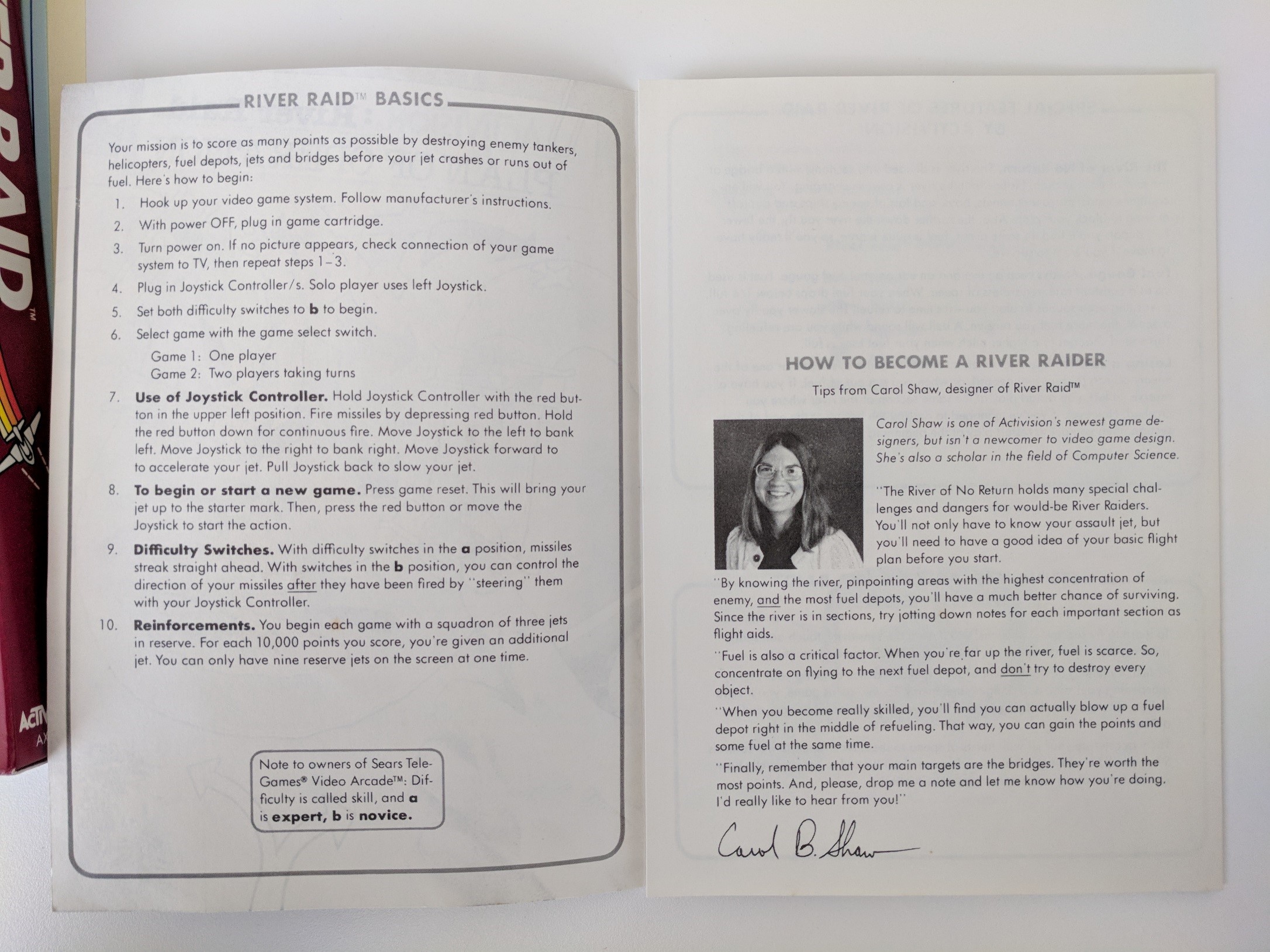 Detail of River Raid instruction manual, introduced by Carol Shaw.
Detail of River Raid instruction manual, introduced by Carol Shaw.
Carla Meninsky
In Atari’s early years, Carla Meninsky was one of only two female employees in Atari’s cartridge design division, along with Carol Shaw. When Meninsky was a teenager, her programmer mother taught her the basics of Fortran. Carla’s academic studies at Stanford began in the mathematics department, but she switched to a major in psychology with a focus in neuroscience. In school, she became interested in building an AI-powered computer animation system and spent her free time playing the text-based Adventure game. Soon after graduation, she pitched her computerized animation idea to Atari, and was hired. Almost immediately, she found herself shuttled into the unintended role of game programmer, working through a list of proposed titles with no actual description. 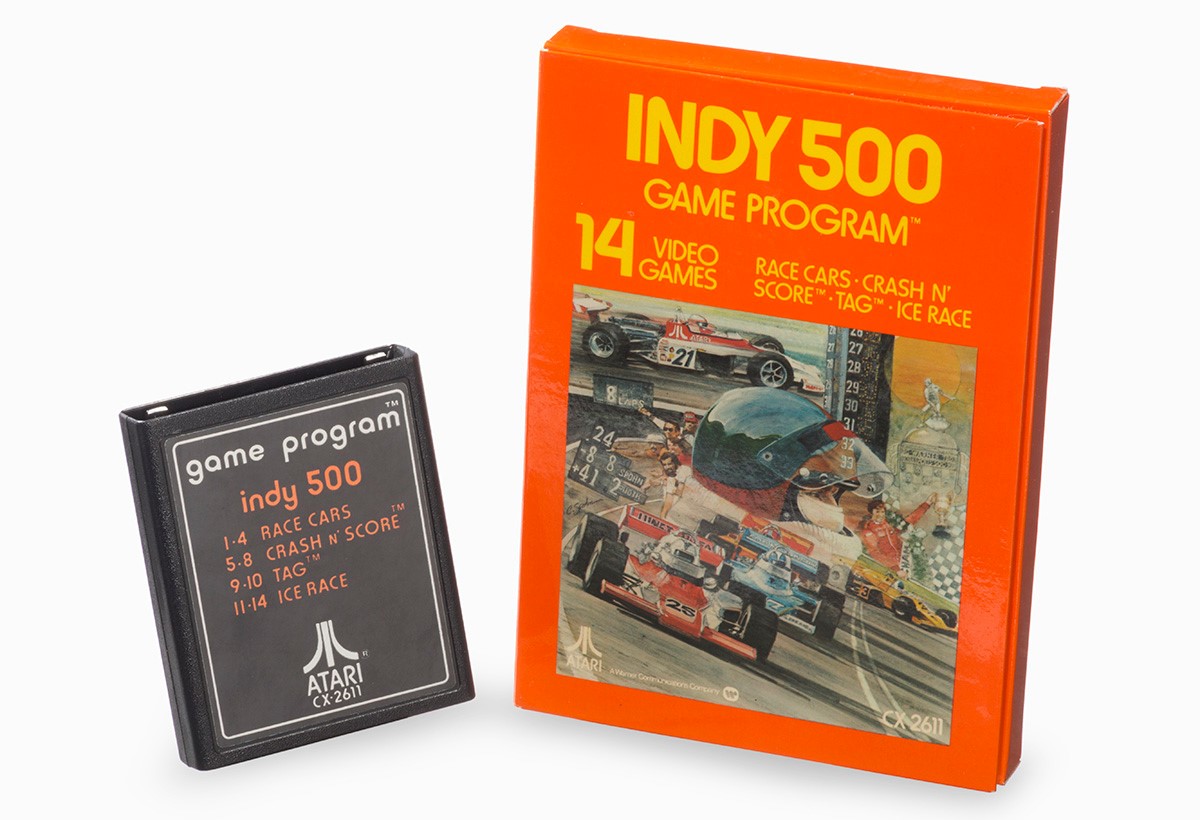 Carla Meninsky and Ed Riddle’s Indy 500 was one of the first of nine titles released with the Atari 2600 launch. THF171078
Carla Meninsky and Ed Riddle’s Indy 500 was one of the first of nine titles released with the Atari 2600 launch. THF171078
Meninsky co-designed Indy 500 with Ed Riddle. When the Atari 2600 launched, this was one of the first nine titles advertised. The game was a bird’s eye view racing game that was a “port” made in the spirit of full-size coin-op arcade games like Indy 800, Grand Trak 10, and Sprint 4. This game could be used with the standard controller, or a special driving controller with a rotating dial that allowed players to have greater control over their vehicles. 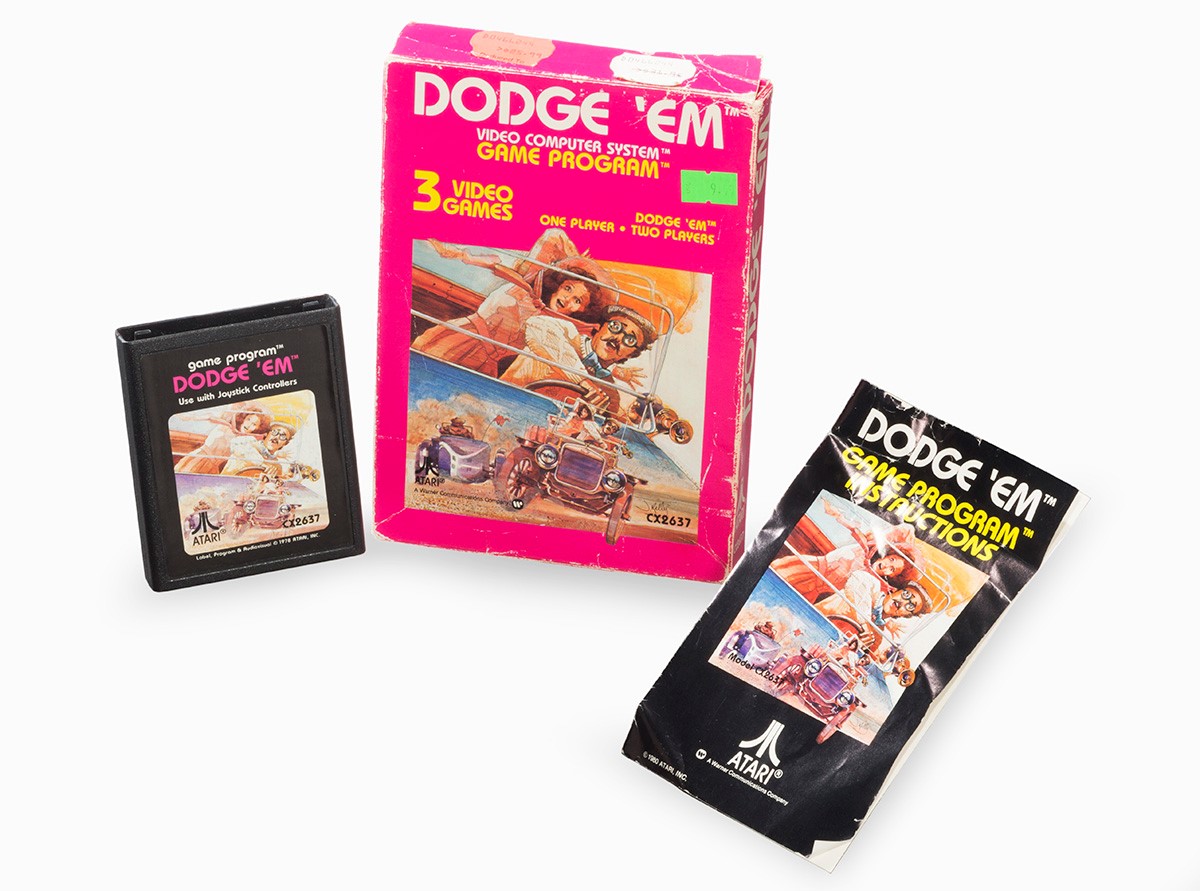 Dodge ‘Em is another driving maze game designed by Carla Meninsky, and was one of the first games she created for Atari. THF171079
Dodge ‘Em is another driving maze game designed by Carla Meninsky, and was one of the first games she created for Atari. THF171079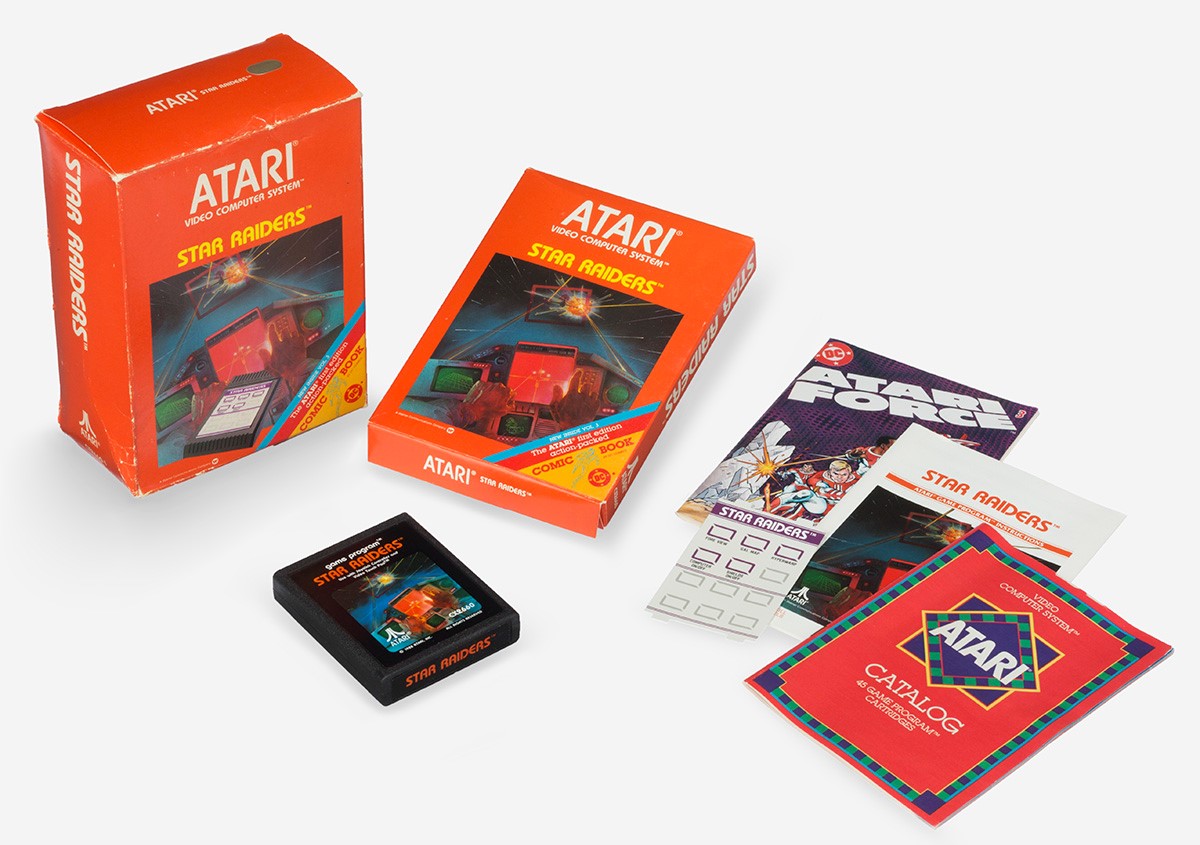 Carla Meninsky’s Star Raiders, 1982. THF171076
Carla Meninsky’s Star Raiders, 1982. THF171076
Star Raiders, also by Meninsky, is a first-person shooter game with a space combat theme. The game was groundbreaking for its advanced gameplay and quality graphics that simulated a three-dimensional field of play. The original version of the game was written by Doug Neubauer for the Atari 8-bit home computer and was inspired by his love for Star Trek. This “port” to the home console market for the Atari 2600 was programmed by Carla Meninsky.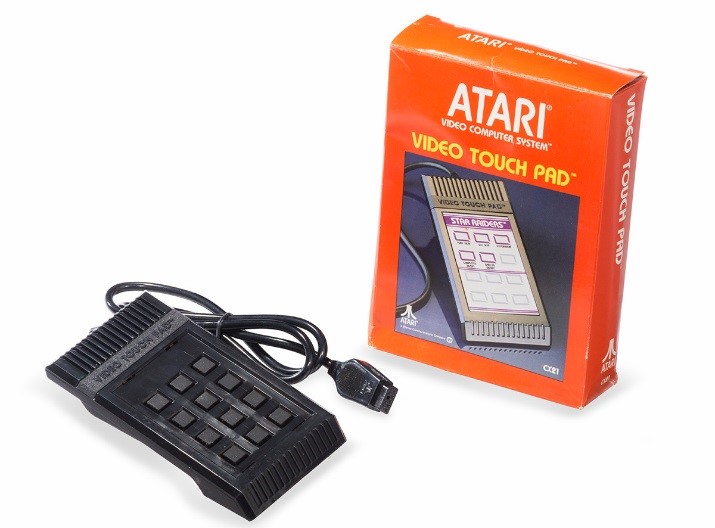
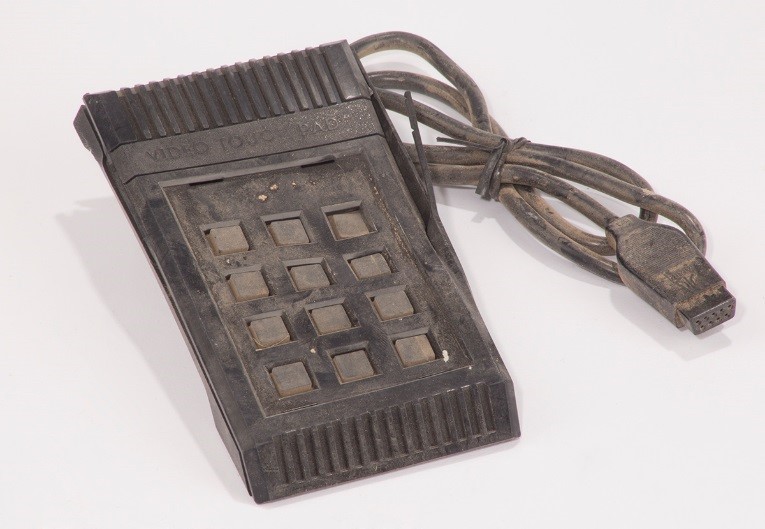 Star Raiders came with a special Video Touch Pad controller. The Henry Ford’s collections house the version sold with the 1982 game, as well as a crushed and dirtied version that was excavated from the “Atari Tomb” in 2013. THF171077 and THF159969
Star Raiders came with a special Video Touch Pad controller. The Henry Ford’s collections house the version sold with the 1982 game, as well as a crushed and dirtied version that was excavated from the “Atari Tomb” in 2013. THF171077 and THF159969
The 2600 version of the game could be used with a regular joystick, or a deluxe version was sold with a special Video Touch Pad controller. This twelve-button touchpad was designed to be overlaid with interchangeable graphic cards, printed with commands for different Atari games. Star Raiders was the only game to make use of this controller—perhaps if it weren’t for the looming “Video Game Crash” of 1983, other developers would have made use of this controller.
Atari was one of the first companies with the types of workplace perks that are now ubiquitous at Silicon Valley companies today. It had a reputation for attracting the young, the rebellious, and the singularly talented. While certain aspects of Atari’s workplace culture might raise eyebrows today (and rightly so), it also doesn’t take much digging to find stories of women who were empowered to make vital contributions to the company. These recent artifact acquisitions—games designed and programmed by female gaming pioneers working at Atari—embody an ambition to represent and celebrate diverse cultures through our technological collections.
Kristen Gallerneaux is the Curator of Communications and Information Technology at The Henry Ford.
toys and games, California, 20th century, 1980s, 1970s, women's history, video games, technology, home life, design, by Kristen Gallerneaux
Highlights from CES 2018
Every January, the tech world descends upon Las Vegas for the Consumer Electronics Show. In 2018, over 4000 global companies displayed their products and ideas, spread throughout 2.6 million square feet of exhibition space in the Las Vegas Convention Center and ten hotels. Nearly 185,000 industry professionals, exhibitors, and media from around the world attended this year. By the numbers, it is an impressive event.
Many successful home technologies have made their debut at CES over its 51-year run: VCRs, camcorders, CD players, DVDs, tablet computers—even the original Nintendo Entertainment System and Xbox. This year’s trends included the forthcoming “5G network,” digital health and fitness, and improved autonomous vehicles. One “battle” visible on the show floor was the widespread adoption of voice-command technology—from smart speakers in the home to command modules in vehicles—and which platform would reign. Ask Alexa. Hey Google. Hi Bixby.
CES has been known to “make or break” companies. Established companies use the event as a forum to launch new products, improve existing devices, or inadvertently—present the occasional flop. Likewise, the 600+ startup companies that populate the specialized “Eureka Park” section angle to find the right pair of eyes on their idea and to secure funding for marketplace production.
Even with two curators on the ground, it was impossible to see everything. What follows is a sampling of our Curator of Communication & Information Technology and our Curator of Transportation’s favorite “CES Moments.” 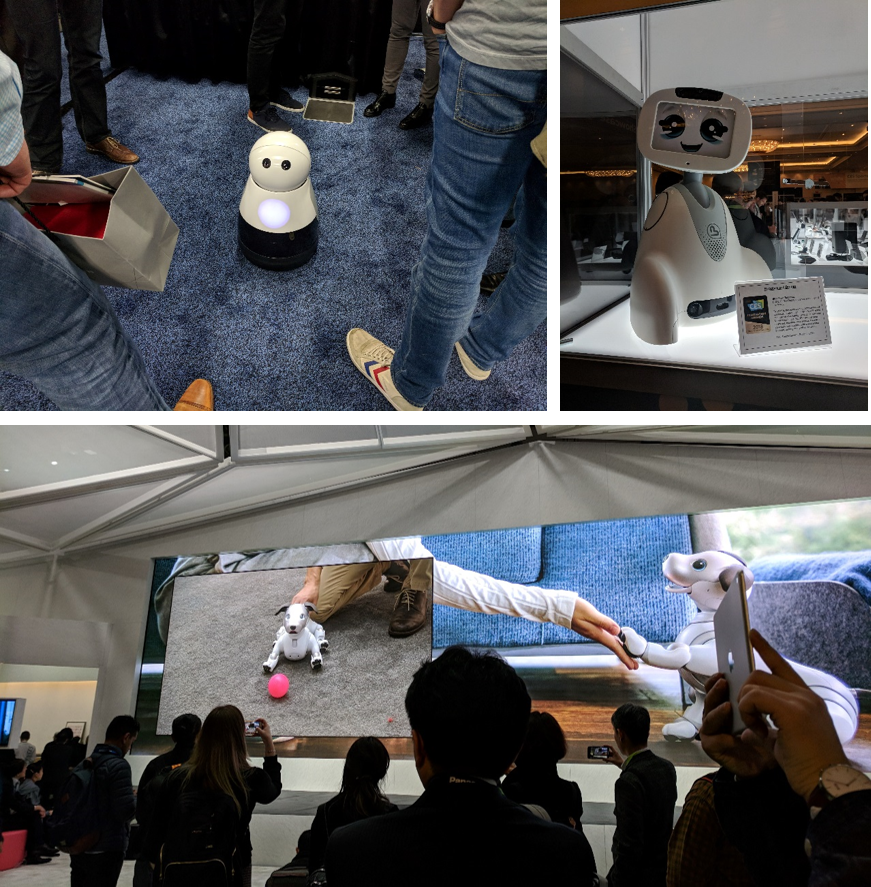
Here come the robots! Some of them can’t be described as anything but “cute,” like this Kuri model (upper left) from Mayfield Robotics. Also popular was Blue Frog’s “Buddy,” (upper right) and Sony’s Aibo the robot dog (bottom). All three of these devices are designed as “companion robots” and have a variety of expressive features. Today’s robots are equipped with facial recognition, cameras for capturing life’s moments, and often double as home security. 
Analog is always new again! The proliferation of quality cellphone cameras and social media has all but locked our memories into digital landscapes. But people remain hungry for physical media and printed photographs. This year at CES, Kodak displayed the Printomatic (right) and Polaroid announced the OneStep 2—an instant camera blending old and new technology (left, middle). The colorful film options and iconic square format should look familiar to today’s Instagrammers.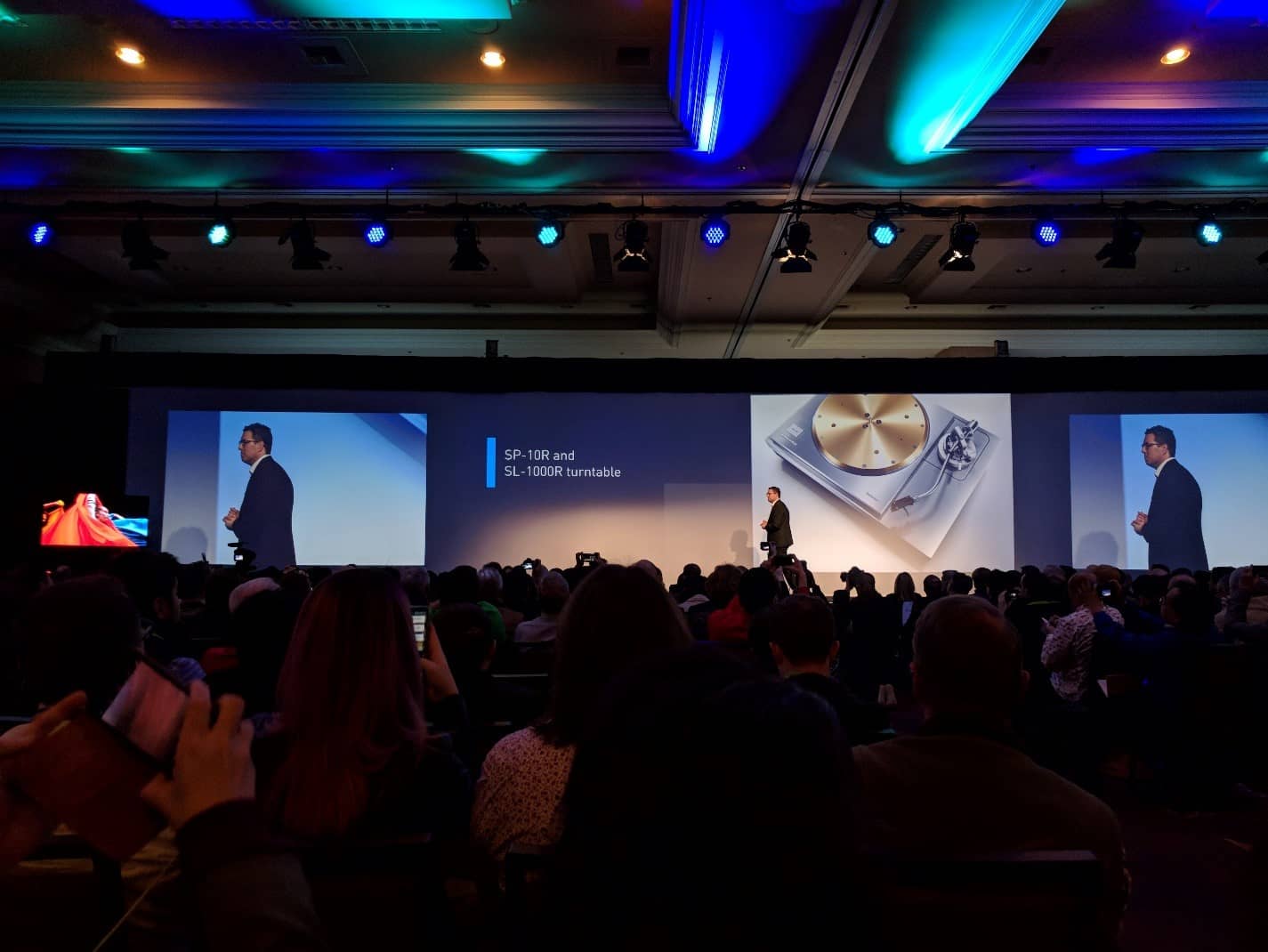
Continuing in the analog spirit… When the Technics SL-1200 record turntable debuted in 1972, its direct-drive technology made it an immediate hit not just with consumers but also with radio and club DJs. These robust “Wheels of Steel” played an essential role in the early years of hip hop record scratching and live dance music mixing. While the SL-1200 went out of production in 2010, many 1970s-era Technics remain in use today. At 2017’s CES, the coveted device began production once again. This year, Technics announced a new high-end turntable—the SL-1000R—which carries over the best qualities of the SL-1200. While the drastic rise in recent vinyl sales is often touted as a “revival,” the commitment of companies to produce quality turntables is evidence that the medium never really went away. 
There was a lot of buzz at CES 2018 about the coming of the “voice assistant wars” between Amazon’s Alexa, Google Assistant, and a flood of startups finding their way into the mix. Voice-activated technology is nearly ubiquitous, as we have learned to ask Siri and Google for directions. And smart home devices—especially interactive speakers—have become more commonplace as we use them not only to listen to music and podcasts, but also to seek out information like weather, steps to a recipe, or to set up reminders. Our tech curator’s biggest CES disappointment was the heavy rains and floods that forced the Google Assistant booth to close, as well as that fun looking slide to the left.

Growing plants – that’s technology too! A variety of companies presented vertical hydroponic growing systems, geared towards health-savvy consumers who wish to take control of the food they consume. The SmallGarden by ēdn (right) and products by Opcom Farm (left) have married stylish, scalable design with LED lighting and intelligent automation.
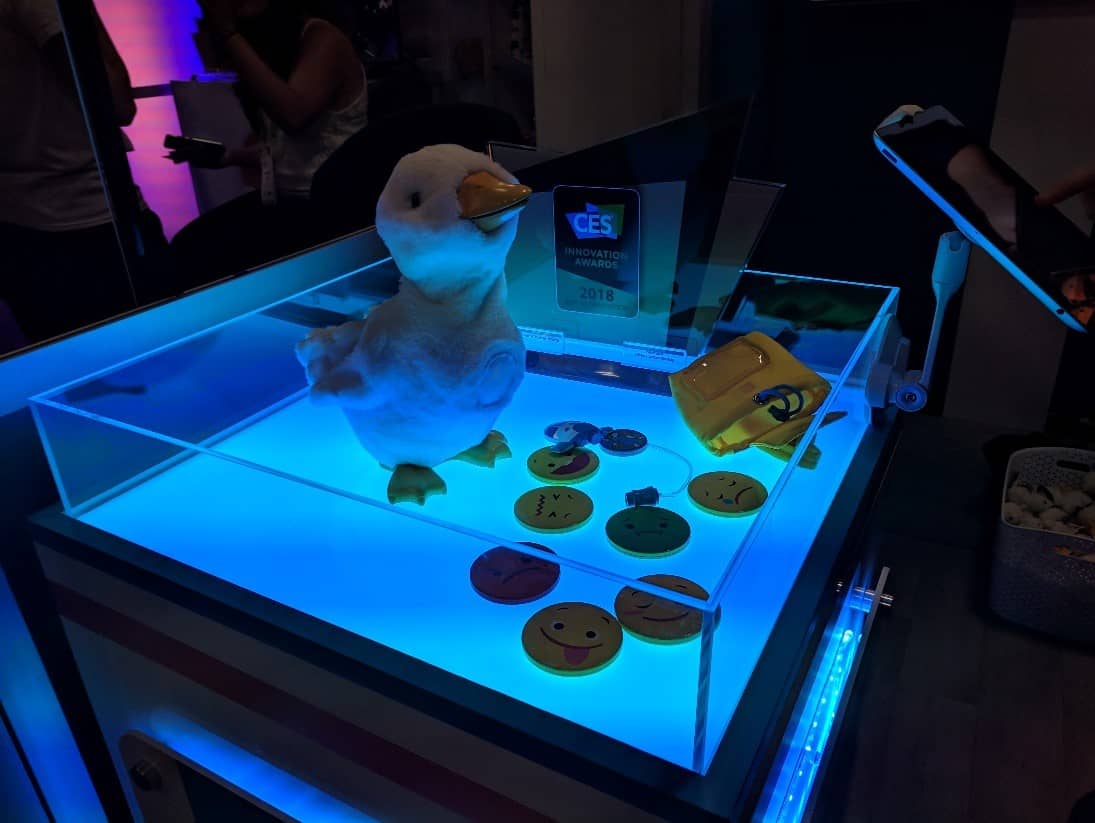
And perhaps our tech curator’s favorite item at CES this year was this robotic duck, designed through a partnership between Aflac and Sproutel. The award-winning “My Special Aflac Duck” is designed to help children cope with cancer treatment. Its touch sensors respond with soothing sounds when it is cuddled with, and it teaches young children calming breathing exercises while they undergo IV treatments. Round RFID chips containing emoji faces are meant to mirror emotions—when tapped against the duck, the toy will then reflect its patient’s feelings by groaning or quacking happily. An accessory even allows kids to play out administering “medication.” These features combine to allow young patients to communicate their emotions effectively, take on the role of caregiver, and reduce anxiety. The duck will be tested at an Atlanta treatment center this year, with the future goal of donating the social robot to any child diagnosed with cancer, nationwide.
While it’s not quite the North American International Auto Show, CES is an increasingly important venue for automakers to debut new technologies, or to announce new partnerships with tech-savvy firms. If the automotive side of this year’s show was to be captured in a single word, it’s “autonomy.” Self-driving vehicles are on everyone’s mind – we’re no longer talking about this tech in terms of “if,” but “when.”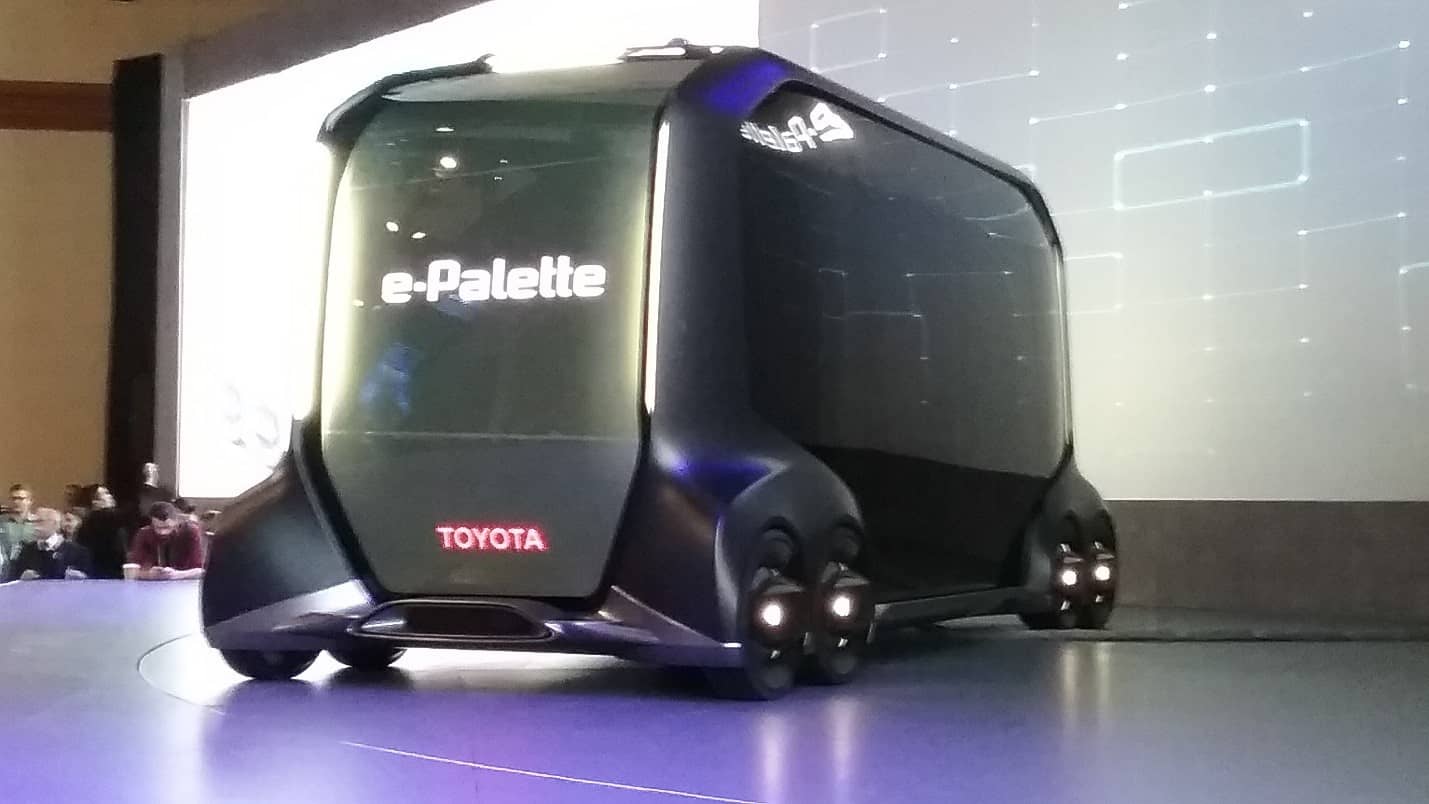
Toyota president Akio Toyoda spoke clearly to the growing overlap between the automotive and tech worlds when he noted that his company’s competitors now include not only carmakers like General Motors, Volkswagen and Honda, but also firms like Google, Apple and Facebook. Toyoda sees the car evolving into a personal assistant, using predictive artificial intelligence to anticipate the travel needs of its owner. And, like a growing number of other industry members and observers, he also predicts the inevitable – if slow – extinction of the internal combustion engine. Toyota and Lexus plan to offer electric or hybrid versions of every one of their models by 2025.
Toyota’s big CES announcement focused on its e-Palette concept (above). The fully-autonomous electric vehicle is designed for maximum flexibility. An e-Palette could serve as a bus providing ride sharing services. It could work as a mobile store bringing goods to your front door on demand. It could even function as a rolling flexible workspace, giving us back some of those 38 hours that the average American loses to traffic congestion each year. Companies like Amazon, Pizza Hut and Uber have already agreed to partner with Toyota in e-Palette’s development.
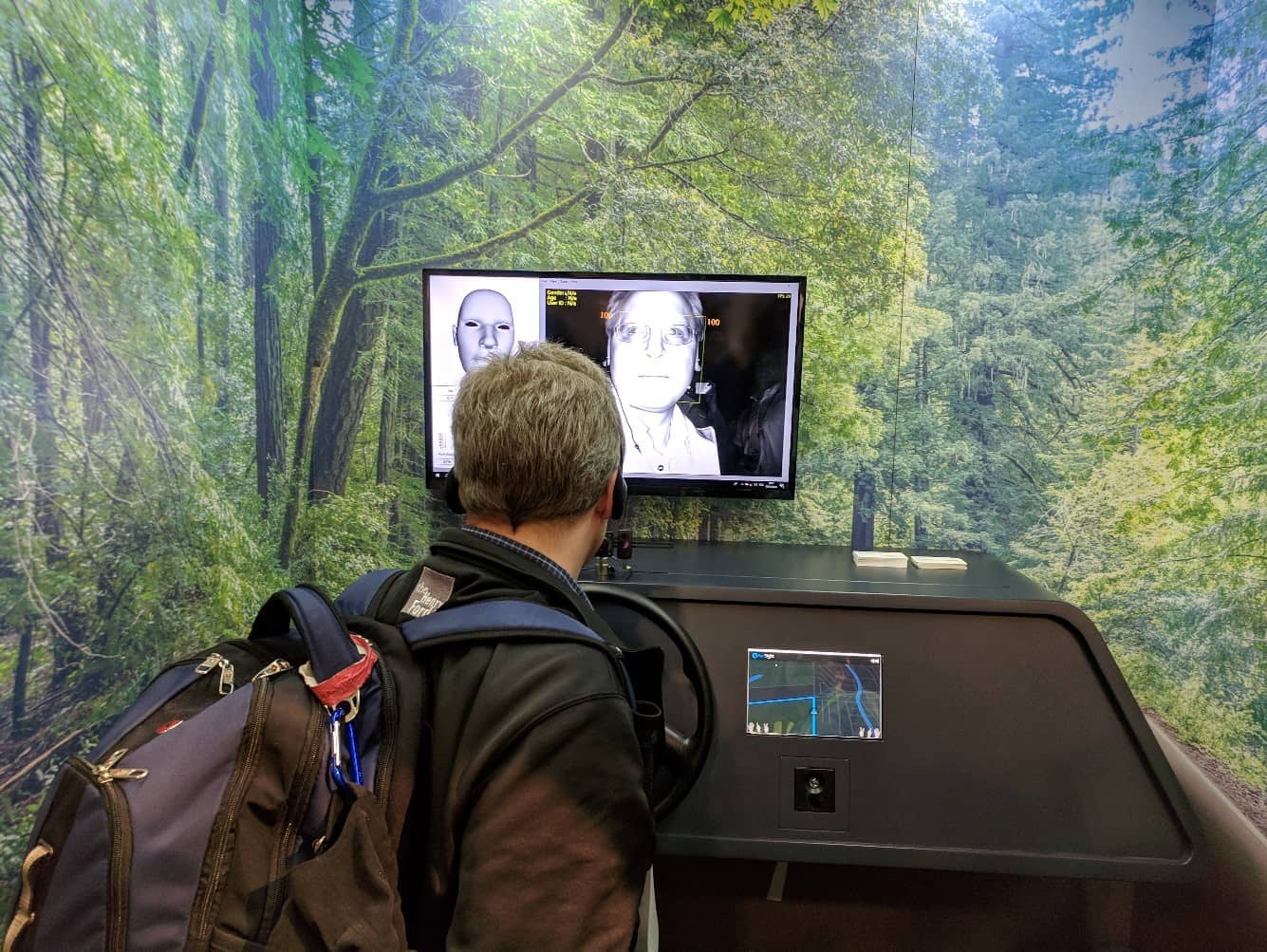
Self-driving cars offer more than mere productivity. Safety promises to be their greatest benefit. Some 35,000 people die in motor vehicle accidents in the U.S. each year, and 90 percent of those accidents are due to human error. Eliminate the human element, so the thinking goes, and you eliminate the vast majority of those deaths.
Sophisticated lifesaving tools are here today. CES exhibitor eyeSight Technologies uses in-car sensors to track driver eye movement, blink rate and head pose (above). Look away from the road – say, at your phone – for too long and the system can trigger an audible alarm. Blink too often or for too long – perhaps because you’re too drowsy to drive – and the system could conceivably cause the car to slow down and pull off to the side of the road.
There are still many problems to solve before we have fully-autonomous cars in every garage. Who’s liable in an accident? The carmaker, the programmer, the owner? What happens when you’re traveling in a remote area with poor broadband service – and no GPS? What happens in the “transition” period, when self-driving cars share the road with human-driven vehicles? Can they communicate with one another? And the biggest question of all: Will people be comfortable putting their lives in a computer’s hands? But, ready or not, this new world is coming. In fact, it had already arrived at CES – Lyft and Aptive partnered to provide rides around Las Vegas in autonomous BMWs.

When you think about the relationship between humans and self-driving cars, remember that it’s not just the humans inside the car. How pedestrians, cyclists and other street users interact with an autonomous vehicle is equally important. Ford’s CES booth featured a van at the center of an interesting research project (above). In the study, a driver camouflages himself in a seat-cover costume – yes, really – and then drives around gauging people’s reactions. How disconcerting is it to see an empty van rolling toward the crosswalk? And how confident can you be that it’ll stop for you?
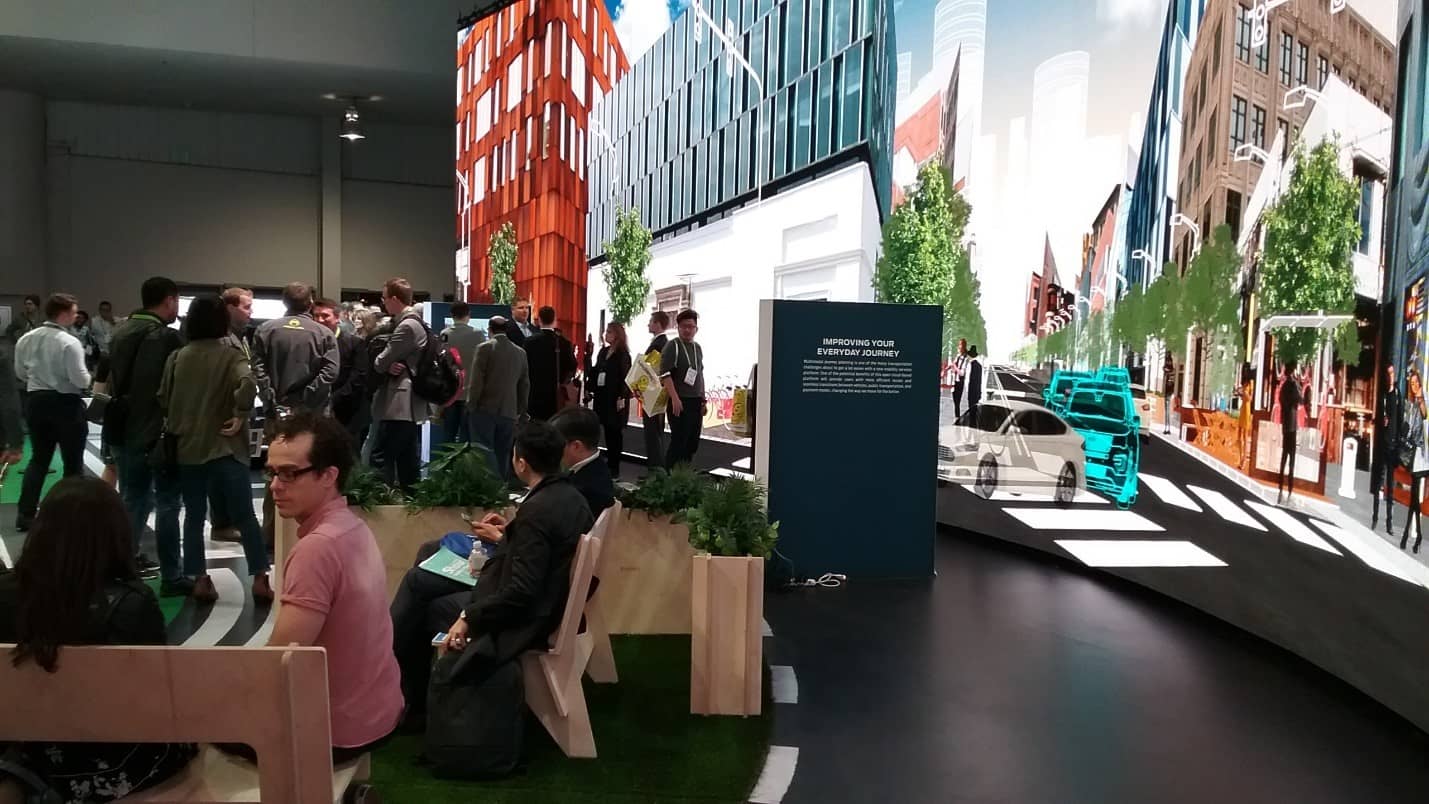
Ford and Toyota both emphasized that they’re not in the car business anymore – they’re in the mobility business. The recreated streetscape in Ford’s booth included not only the van and an autonomous Fusion sedan, but also bicycles, skaters and pedestrians. Ride sharing and self-driving vehicles will reduce traffic, either by cutting the number of cars on the road, or by using roads more efficiently. It’s a dream come true for urbanists who’ve long searched for ways to reclaim pavement for uses other than moving and/or parking cars. (Ever hear the term woonerf? You will!) In fact, Ford’s street even included park benches and grass in a reclaimed lane (above).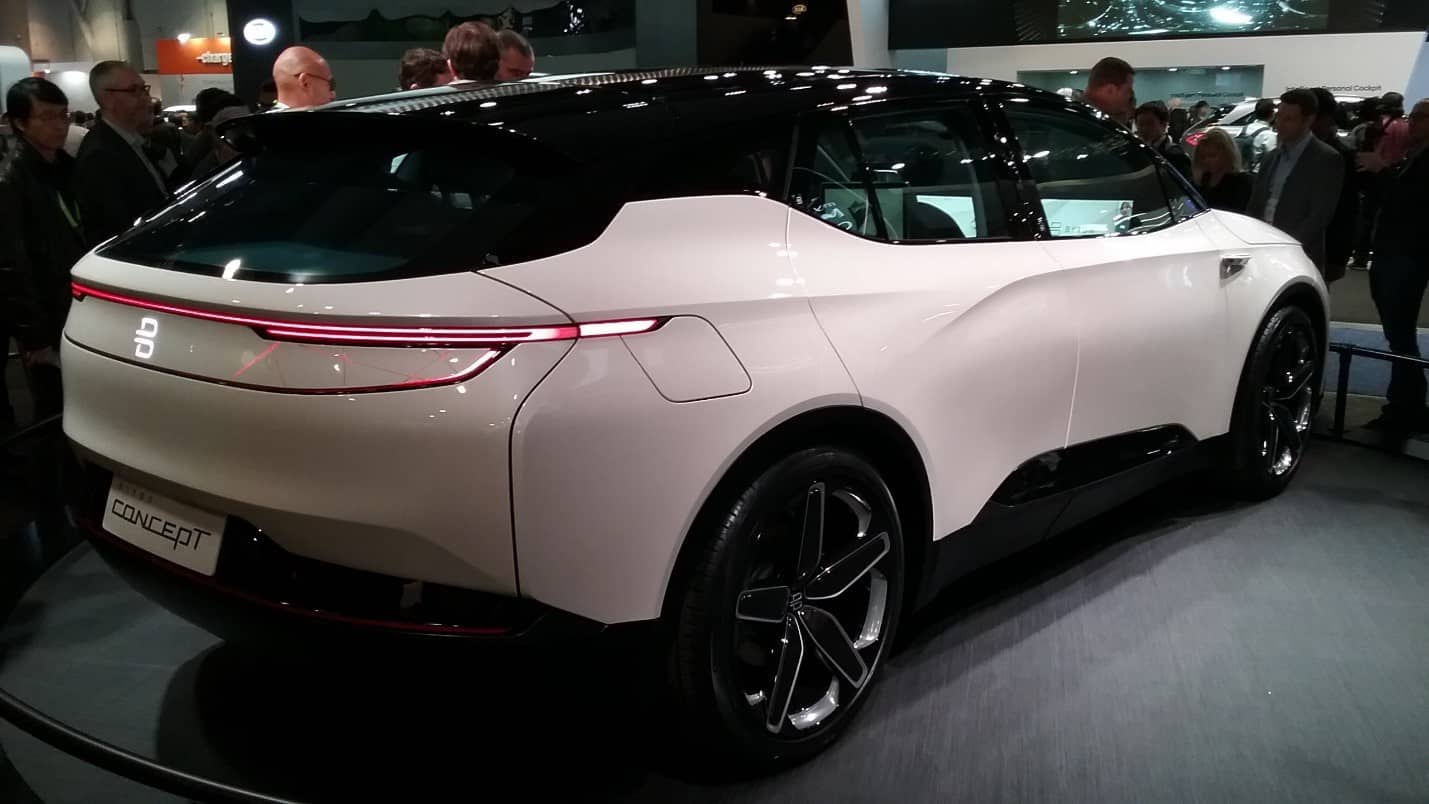
The twin revolutions of the electric powertrain and autonomous capability may provide the best opportunity to get into the car business since just after World War II. Few newcomers attracted as much attention at CES as Byton. The Chinese manufacturer plans to enter the American market in 2020 with a battery-powered Level 3 autonomous car capable of up to 325 miles between charges (above). Instead of a dashboard, Byton’s car uses a 49-inch screen. And instead of knobs and buttons – or even a touchscreen – passengers control the car’s features with hand gestures. And you don’t even have to worry about locking your keys in the car – the Byton’s doors are unlocked with facial recognition software.
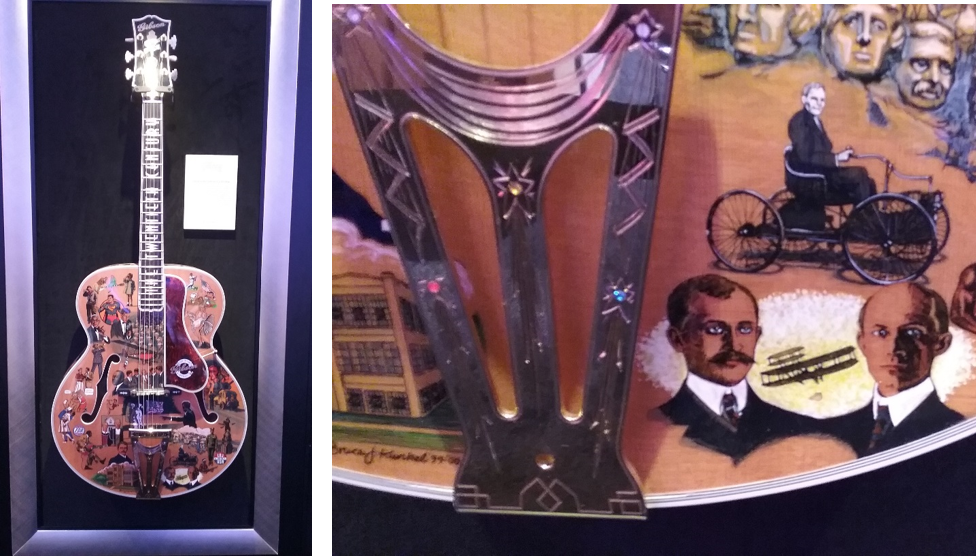
And finally, for something completely different, the prize for Most Unexpected Quadricycle Sighting goes to… Gibson Guitars (above). The company’s special edition “20th Century Tribute” archtop, on display in its CES tent, featured images of influential people, technologies and events from the past century. Note that Orville and Wilbur Wright had a well-deserved spot, too!
Kristen Gallerneaux is Curator of Communication & Information Technology at The Henry Ford. Matt Anderson is Curator of Transportation at The Henry Ford.
autonomous technology, cars, communication, music, photography, events, technology, by Matt Anderson, by Kristen Gallerneaux
Can Objects Talk?
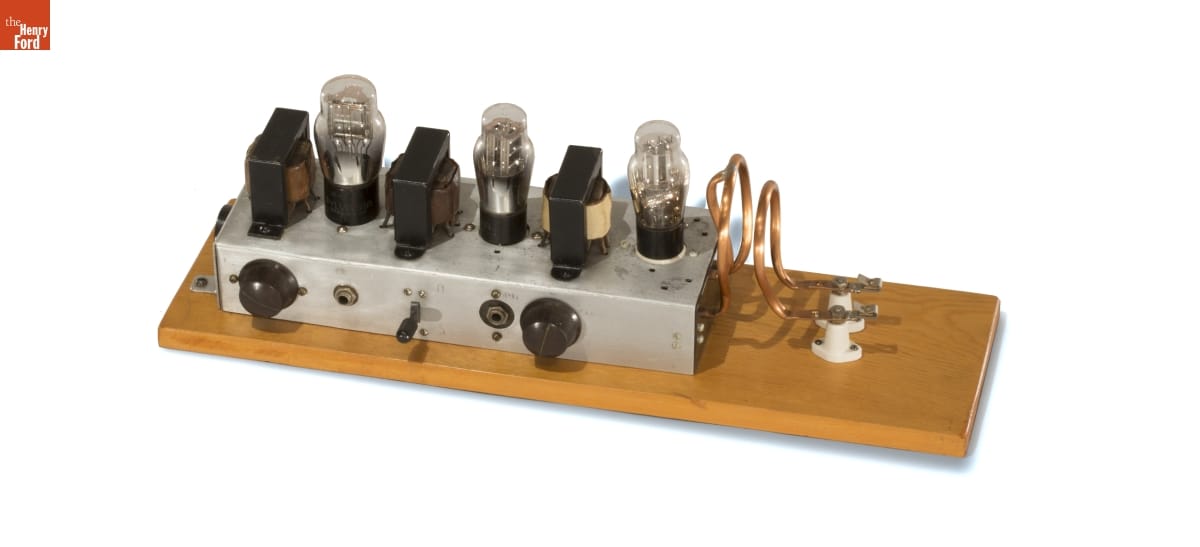
THF155560 / Radio Receiver Used in the Piccards' Stratospheric Balloon Ascension, 1934.
Objects have a tendency to develop lives and stories of their own, and I love figuring out the various ways they “speak” to us, the networks and worlds they form, and the variety of angles they can be looked at from. Part of the challenge of studying the history of media, information and communication is in knowing how to draw scattered data back together again, and how to weave a story out of it, to make it accessible and interesting — all the while rooting it to the object in question.
The microlevel details and histories of objects can be coaxed into connecting to big ideas. For example, the same “never leak” gaskets used in the modest Star-Rite electric toaster were also used in the engine of the Spirit of St. Louis airplane. So here, gaskets migrate out of the kitchen to become silent players that made the first transatlantic flight possible. This, in turn, connects not only to the development of aero technology but also to the desire to conquer space and time.
It makes me think of a shortwave radio receiver in our collection that was custom-built by William Duckwitz for ground communication during a balloon flight. The knobs, wires and tubes are typical of a DIY ethos. The flight itself took off from Ford Airport in 1934 and rose nearly 11 miles into the stratosphere. Who was manning the gondola below the hydrogen-filled balloon? Jeannette Piccard, a streetwise woman with impressive credentials. She was the first woman to be licensed as a balloon pilot and became the first American woman to enter the stratosphere and, technically speaking, space. Piccard once said: “When you fly a balloon, you don’t file a flight plan; you go where the wind goes. You feel like part of the air. You almost feel like part of eternity, and you just float along.”
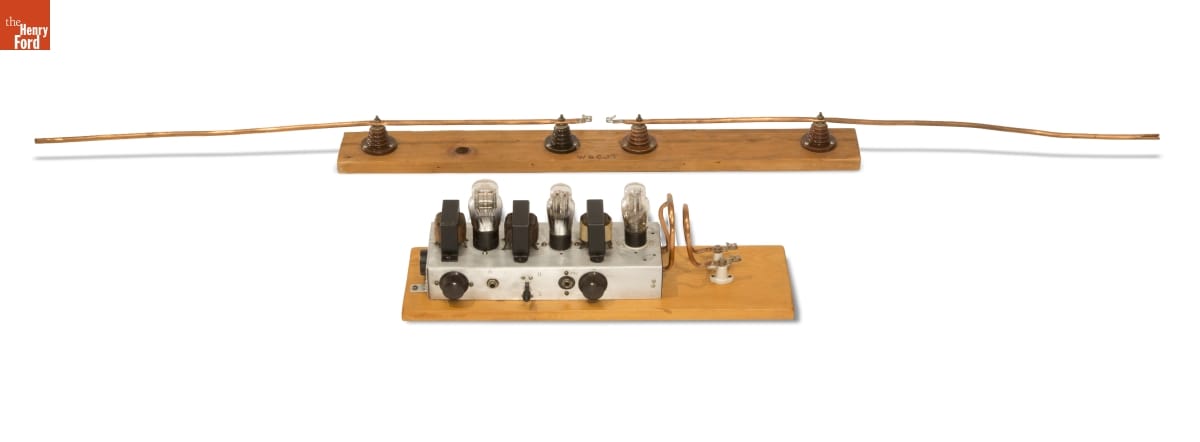
The objects in my curatorial care are essentially a huge collection of “black boxes”— a concept that means the more seamless and successful a technology is, the more mystifying and opaque its inner functions become to the everyday user. And so, another exciting task is to figure out a way to reveal the invisible networks among the collections, to allow patrons to see communications and IT devices and think beyond their sleek shells (or messy tubes and wires) and understand how they relate to ideas, stories, invention and to themselves — as users.
Continue Reading
Ford Radio and Fordlandia
Henry Ford used wireless radio to communicate within Ford Motor Company (FMC) starting after October 1, 1919. This revolutionary new means of communication captured Ford’s interest because it allowed him to transmit messages within his vast operation. By August 1920, he could convey directions from his yacht to administrators in FMC offices and production facilities in Dearborn and Northville, Michigan. By February 1922, Ford’s railroad offices and the plant in Flat Rock, Michigan were connected, and by 1925, the radio transmission equipment was on Ford’s Great Lake bulk haulers and ocean-going vessels. Historian David L. Lewis claimed that “Ford led all others in the use of intracompany radio communications” (The Public Image of Henry Ford, 311).
Ford Motor Company also used radio transmissions to reach external audiences through promotional campaigns. During 1922, FMC sales branches delivered a series of expositions that featured Ford automobiles and Fordson tractors. An article in Motor Age (August 10, 1922) described highlights of the four-month tour of western Oregon:
“The days are given over to field demonstrations of tractors, plows and implements, while at night a radio outfit that brings in the concerts from the distant cities and motion pictures from the Ford plant, keep an intensely interested crowd on the grounds until the Delco Light shuts down for the night.”
The Ford Radio and Film crew that broadcast to the Oregon crowds traveled in a well-marked vehicle, taking every opportunity available to inform passers-by of Ford’s investment in the new technology – radio – and the utility of new FMC products. Ray Johnson, who participated in the tour, recalled that he drove a vehicle during the day and then played dance music in the evenings as a member of the three-piece orchestra, “Sam Ness and his Royal Ragadours.”

Ford and Fordson Power Exposition Caravan and Radio Truck, Seaside, Oregon, 1922 . THF134998
In 1922, Intra-Ford transmissions began making public broadcasts over the Dearborn’s KDEN station (call letters WWI) at 250-watts of power, which carried a range of approximately 360 meters. The radio station building and transmission towers were located behind the Ford Engineering Laboratory, completed in 1924 at the intersection of Beech Street and Oakwood Boulevard in Dearborn.
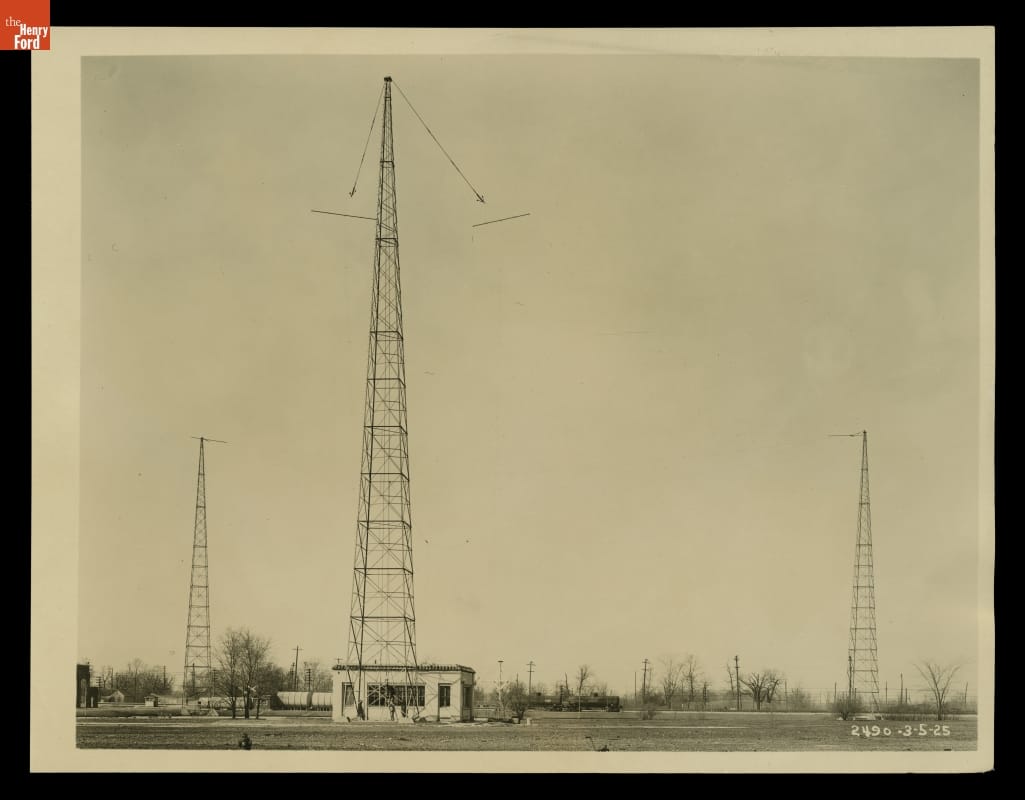
Ford Motor Company Radio Station WWI, Dearborn, Michigan, March 1925. THF134748
Staff at the station, conveying intracompany information and compiled content for the public show which aired on Wednesday evenings.
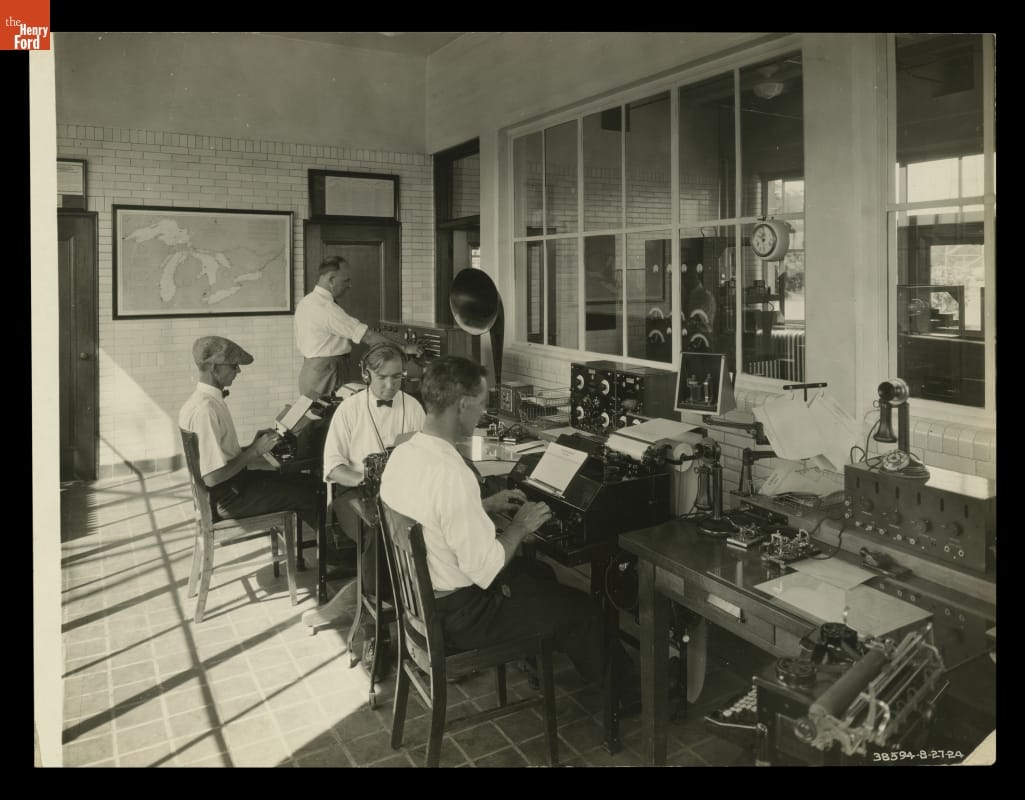
Ford Motor Company Radio Station WWI, Dearborn, Michigan, August 1924. THF134754
The station did not grow because Ford did not want to join new radio networks. He discontinued broadcasting on WWI in early February 1926 (The Public Image of Henry Ford, 179).
Ford did not discontinue his intracompany radio communications. FMC used radio-telegraph means to communicate between the head office in Dearborn and remote locations, including, Fordlandia, a 2.5-million-acre plantation that Ford purchased in 1927 and that he planned to turn into a source of raw rubber to ease dependency on British colonies regulated by British trade policy.
Brazil and other countries in the Amazon of South American provided natural rubber to the world until the early twentieth century. The demand for tires for automobiles increased so quickly that South American harvests could not satisfy demand. Industrialists sought new sources. During the 1870s, a British man smuggled seeds out of Brazil, and by the late 1880s, British colonies, especially Ceylon (today Sri Lanka) and Malaysia, began producing natural rubber. Inexpensive labor, plus a climate suitable for production, and a growing number of trees created a viable replacement source for Brazilian rubber.
British trade policies, however, angered American industrialists who sought to establish production in other places including Africa and the Philippines. Henry Ford turned to Brazil, because of the incentives that the Brazilian government offered him. His goals to produce inexpensive rubber faced several hurdles, not the least of which was overcoming the traditional labor practices that had suited those who harvested rubber in local forests, and the length of time it took to cultivate new plants (not relying on local resources).
Ford built a production facility on the Tapajós River in Brazil. This included a radio station. The papers of E. L. Leibold, in The Henry Ford’s Benson Ford Research Center, include a map with a key that indicated the “proposed method of communication between Home Office and Ford Motor Company property on Rio Tapajos River Brazil.” The system included Western Union (WU) land wire from Detroit to New York, WU land wire and cable from New York to Para, Amazon River Cable Company river cable between Para and Santarem, and Ford Motor Company radio stations at each point between Santarem and the Ford Motor Company on Rio Tapajós. Manual relays had to occur at New York, Para, and Santarem.
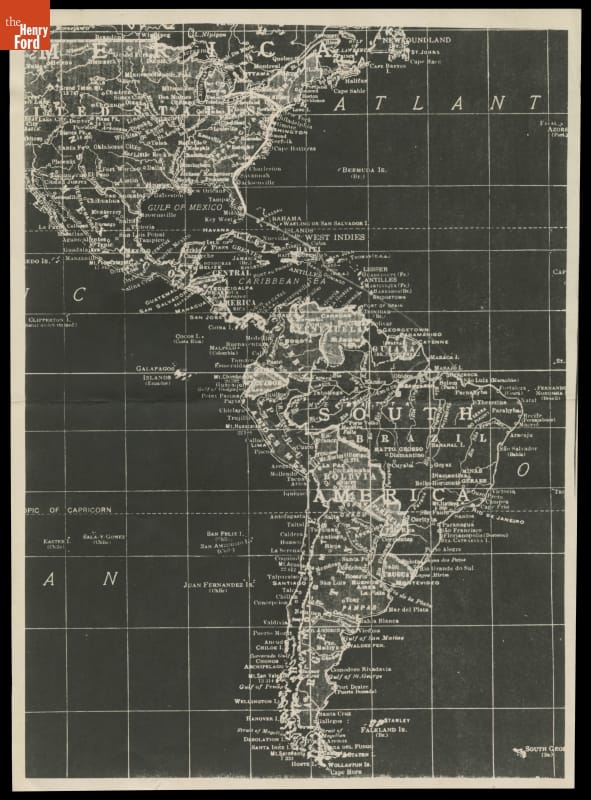
Map Showing Routes of Communication between Dearborn, Michigan and Fordlandia, Brazil, circa 1928. THF134693
Ford officials studied the federal laws in Brazil that regulated radio and telegraph to ensure compliance. Construction of the power house and processing structures took time. The community and corporate facilities at Boa Vista (later Fordlandia) grew. By 1931, the power house had a generator that provided power throughout the Fordlandia complex.
Generator in Power House at Fordlandia, Brazil, 1931. THF134711
Power House and Water Tower at Fordlandia, Brazil, 1931. THF134714
Lines from the power house stretching up the hill from the river to the hospital and other buildings, including the radio power station. The setting on a higher elevation helped ensure the best reception for radio transmissions.
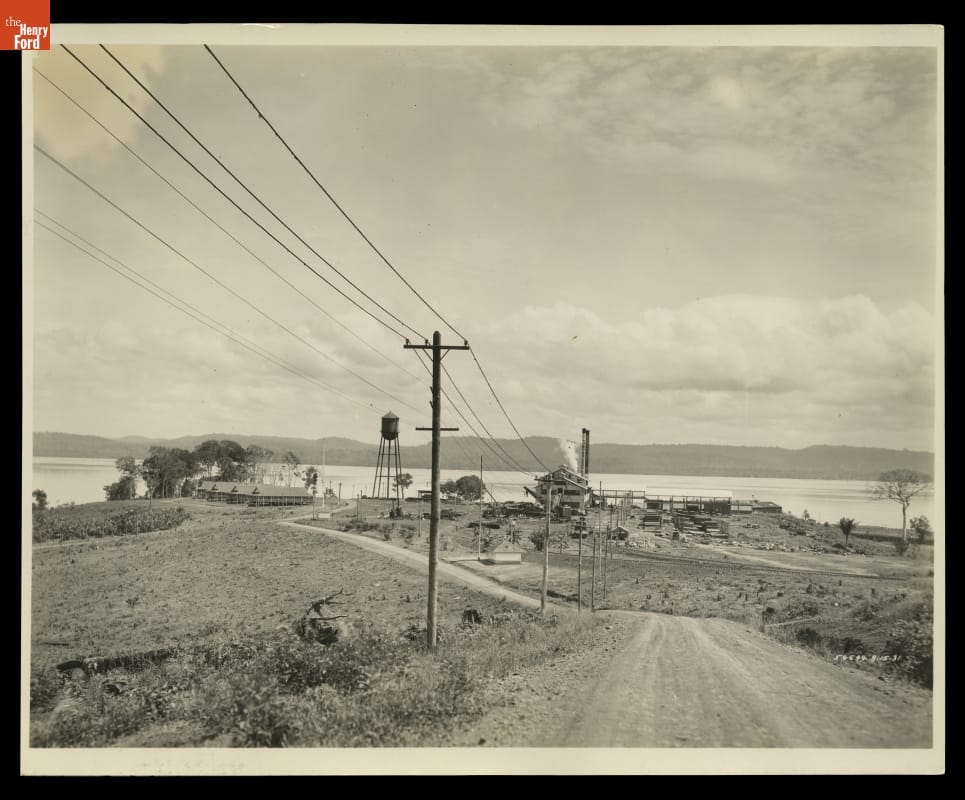
Sawmill and Power House at Fordlandia, Brazil, 1931. THF134717
Workers built the radio power house, which held a Delco Plant and storage batteries, and the radio transmitter station with its transmission tower. The intracompany radio station operated by 1929.
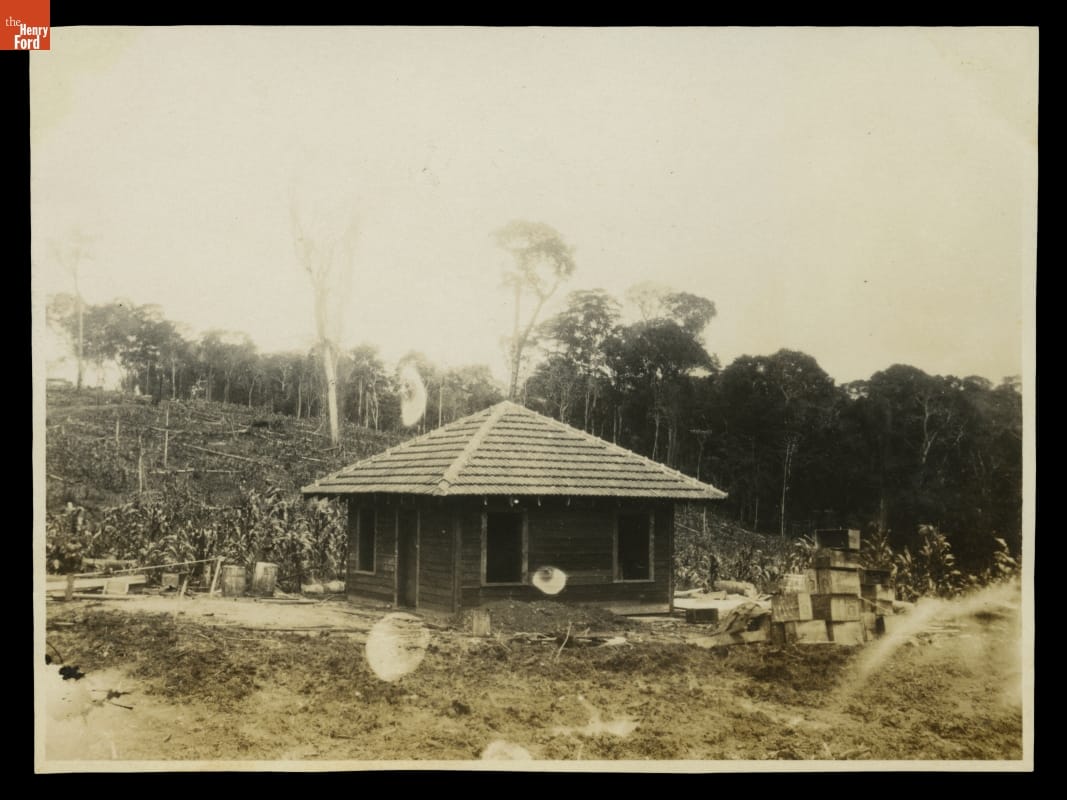
Radio Power House, Fordlandia, Brazil, 1929. THF134697
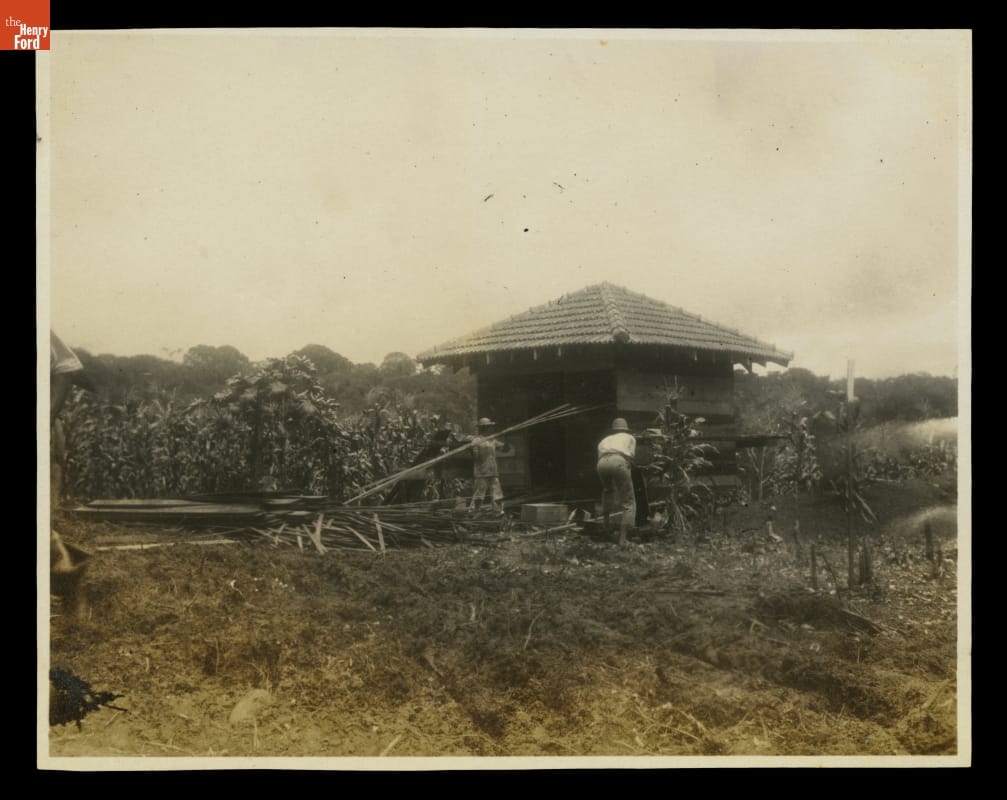
Radio Transmitter House, Fordlandia, Brazil, 1929. THF134699
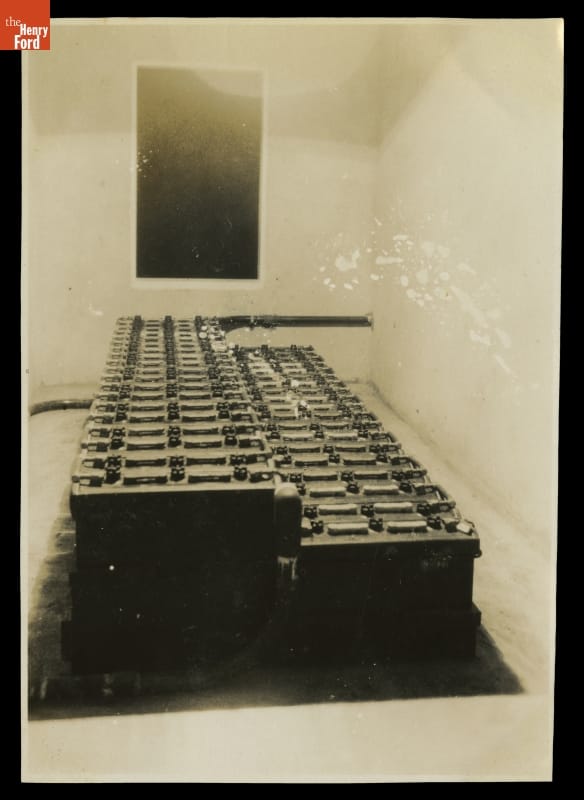
Storage Batteries in Radio Power House, Fordlandia, Brazil, 1929. THF134701
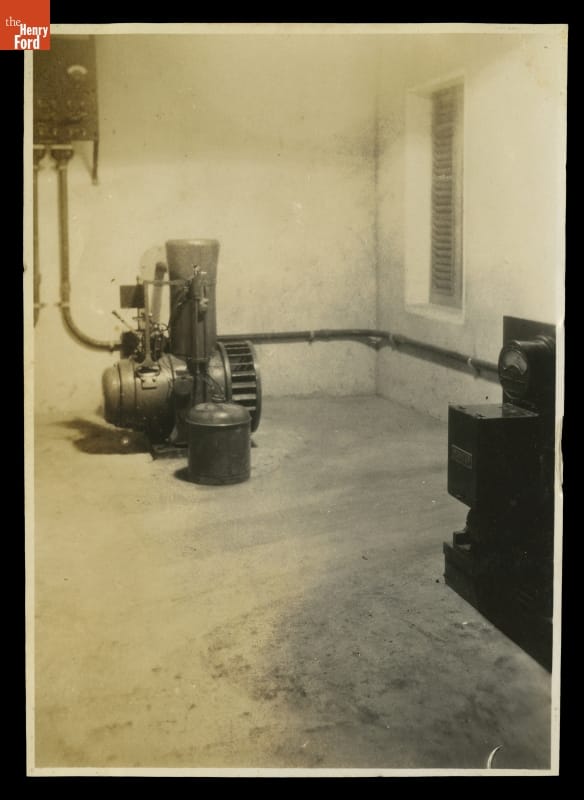
Delco Battery Charger for Radio Power House, Fordlandia, Brazil, 1929. THF134703
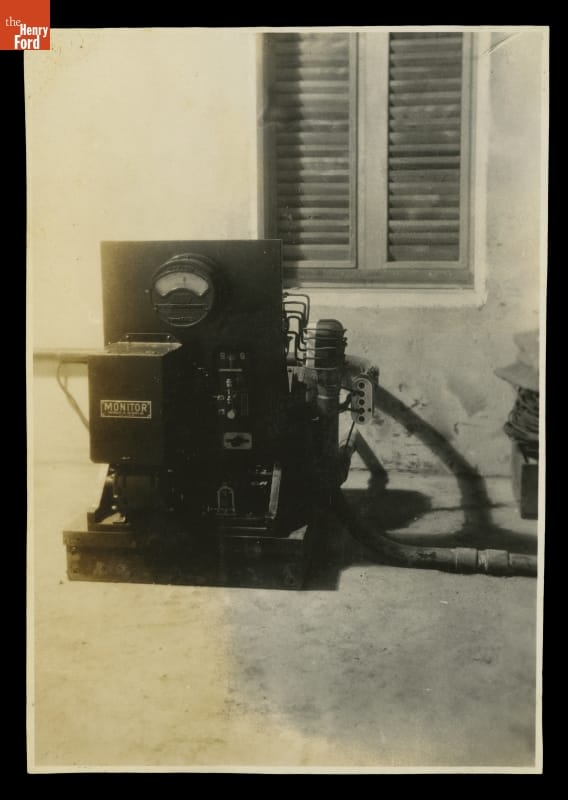
Radio Power House Motor Generator Set, Fordlandia, Brazil, 1929. THF134705
The radio power house is visible at the extreme left of a photograph showing the stone road leading to the hospital (on an even higher elevation) at Fordlandia.
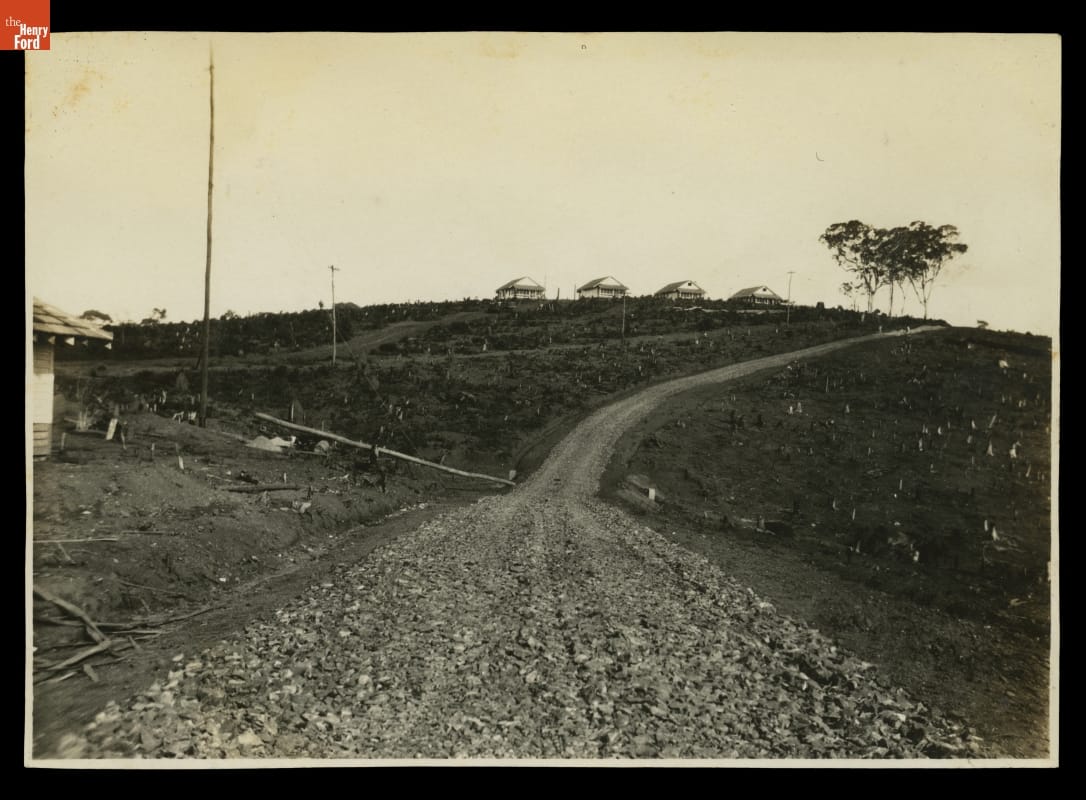
Stone Road Leading to Hospital, Fordlandia, Brazil, 1929. THF134709
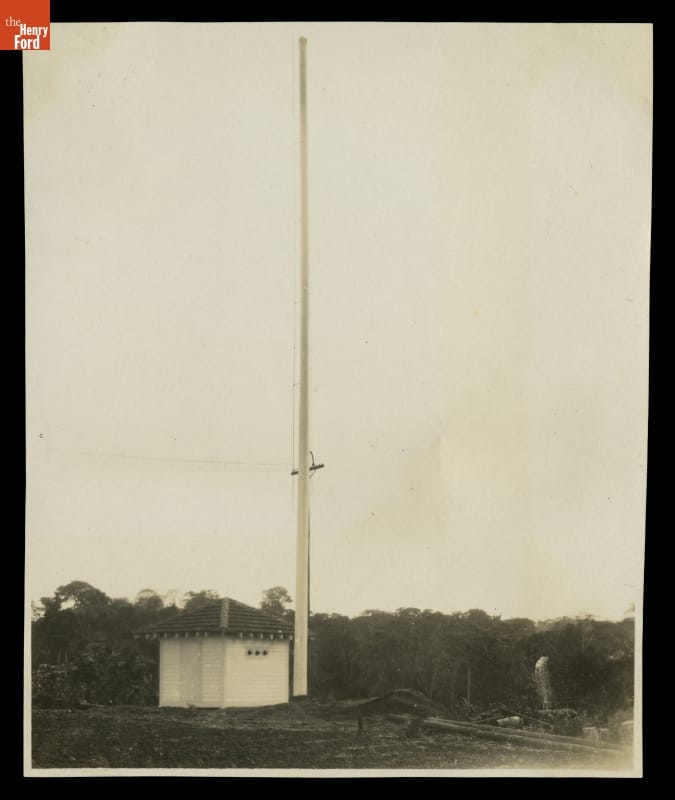
Radio Transmitter Station, Fordlandia, Brazil, 1929. THF134707
Back at FMC headquarters in Dearborn, Ford announced in late 1933 that he would sponsor a program on both NBC and CBS networks. The Waring show aired two times a week between 1934 and 1937, when Ford pulled funding. Ford also sponsored World Series broadcasts. The most important radio investment FMC made, however, was the Ford Sunday Evening Hour, launched in the fall of 1934. Eighty-six CBS stations broadcast the show. Programs included classical music and corporate messages delivered by William J. Cameron, and occasionally guest hosts. Ford Motor Company printed and sold transcripts of the weekly talks for a small fee.
On August 24, 1941 Linton Wells (1893-1976), a journalist and foreign correspondent, hosted the broadcast and presented a piece on Fordlandia.
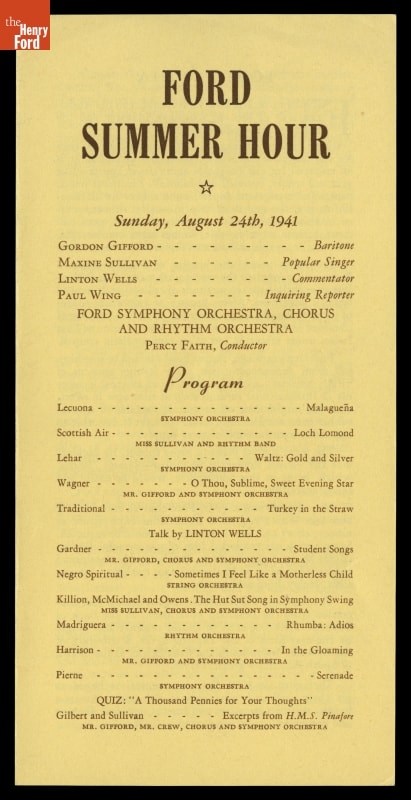
Program, "Ford Summer Hour," Sunday, August 24, 1941. THF134690
Linton Wells was not a stranger to Henry Ford’s Greenfield Village, he and his wife, Fay Gillis Wells, posed for a tintype in the village studio on 2 May 1940.
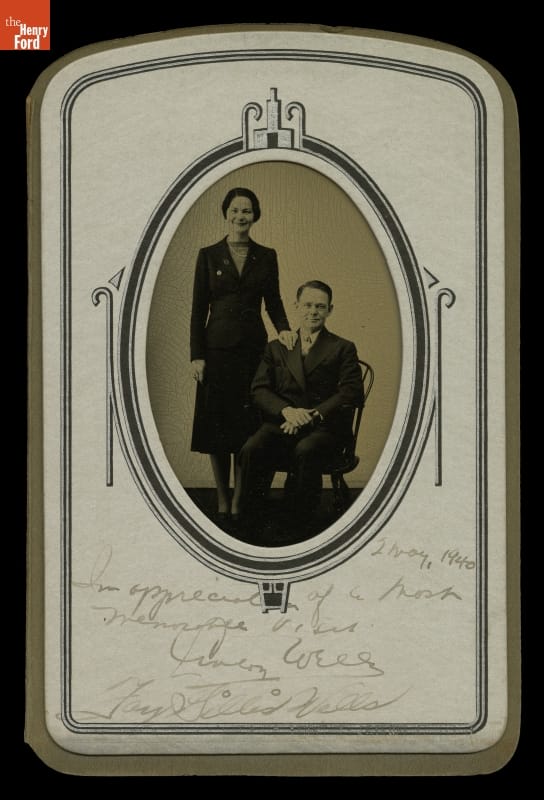
Tintype Portrait of Linton Wells and Fay Gillis Wells, Taken at the Greenfield Village Tintype Studio, circa 1940. THF134720
This radio broadcast informed American listeners of the Fordlandia project, in its 16th year in 1941. Wells summarized the products made from rubber (by way of an introduction to the importance of the subject). He described the approach Ford took to carve an American factory out of an Amazonian jungle, and the “never-say-quit” attitude that prompted Ford to re-evaluate Fordlandia, and to trade 1,375 square miles of Fordlandia for an equal amount of land on Rio Tapajós, closer to the Amazon port of Santarem. This new location became Belterra. Little did listeners know the challenges that arose as Brazilians tried to sustain their rubber production, and Ford sought to grow its own rubber supply.
By 1942, nearly 3.6 million trees were growing at Fordlandia, but the first harvest yielded only 750 tons of rubber. By 1945, FMC sold the holdings to the Brazilian government (The Public Image of Henry Ford, 165).
The Ford Evening Hour Radio broadcasts likewise ceased production in 1942 after eight years and 400 performances.
Learn more about Fordlandia in our Digital Collections.
Debra A. Reid is Curator of Agriculture and the Environment; Kristen Gallerneaux is Curator of Communication and Information Technology; and Jim Orr is Image Services Specialist at The Henry Ford.
Sources
- Relevant collections in the Benson Ford Research Center, The Henry Ford, Dearborn, Michigan.
- Grandin, Greg. Fordlandia: The Rise and Fall of Ford’s Forgotten Jungle City. Picador. 2010.
- Lewis, David L. The Public Image of Henry Ford: An American Folk Hero and His Company. Detroit, Michigan: Wayne State University Press, 1976.
- Frank, Zephyr and Aldo Musacchio. “The International Natural Rubber Market, 1870-1930.″ EH.Net Encyclopedia, edited by Robert Whaples. March 16, 2008.
South America, 20th century, 1940s, 1930s, 1920s, technology, radio, Michigan, Henry Ford, Fordlandia and Belterra, Ford Motor Company, communication, by Kristen Gallerneaux, by Jim Orr, by Debra A. Reid
A Radio for the Beach
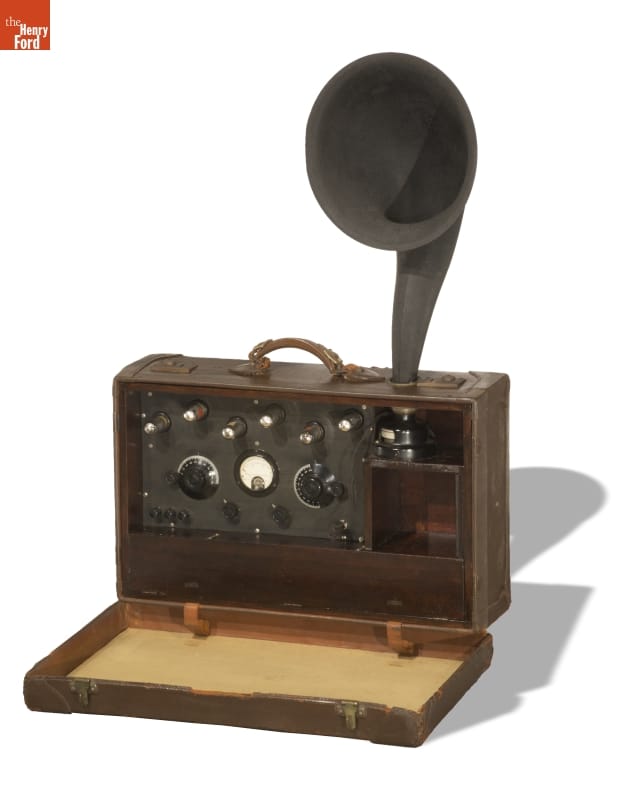
First portable “superhet” radio receiver, made by Edwin Armstrong in 1923. THF 156549
Edwin Armstrong’s First Portable Superheterodyning Receiver
A far cry from today’s pocket-sized MP3 players, the radio pictured above nonetheless advanced the idea of “portable radio.” This device was created in 1923 by Edwin Howard Armstrong—an inventor and pioneering electrical engineer. As the world’s first portable “superhet” radio receiver, this set is powered by six vacuum tubes, has a compartment for a battery, and a detachable horn for amplifying sound. It can be latched shut and conveniently carried by its handle, like a suitcase.
Armstrong’s legacy is rooted in three essential advances in radio history: regenerative circuits, superheterodyning, and frequency modulation (known to us today as FM radio). Individually, each of these concepts acted as some of the most important discoveries in radio history. Together, they helped to raise radio up to a new level. These concepts amplified radio waves, allowing voices to be carried rather than the dots and dashes of Morse code, and by extension, turned radio into an accessible and collective experience.
Superheterodyning
The superheterodyning principle discovered by Armstrong is embedded within the radio receiver above, and has carried over to virtually every modern radio created since. Heterodyning involves mixing two different radio frequencies to create a third frequency, which could be used to tap into very sensitive high-frequency radio waves. Modern radio as well as televisions and cell phones owe a lot to the “superhet” concept.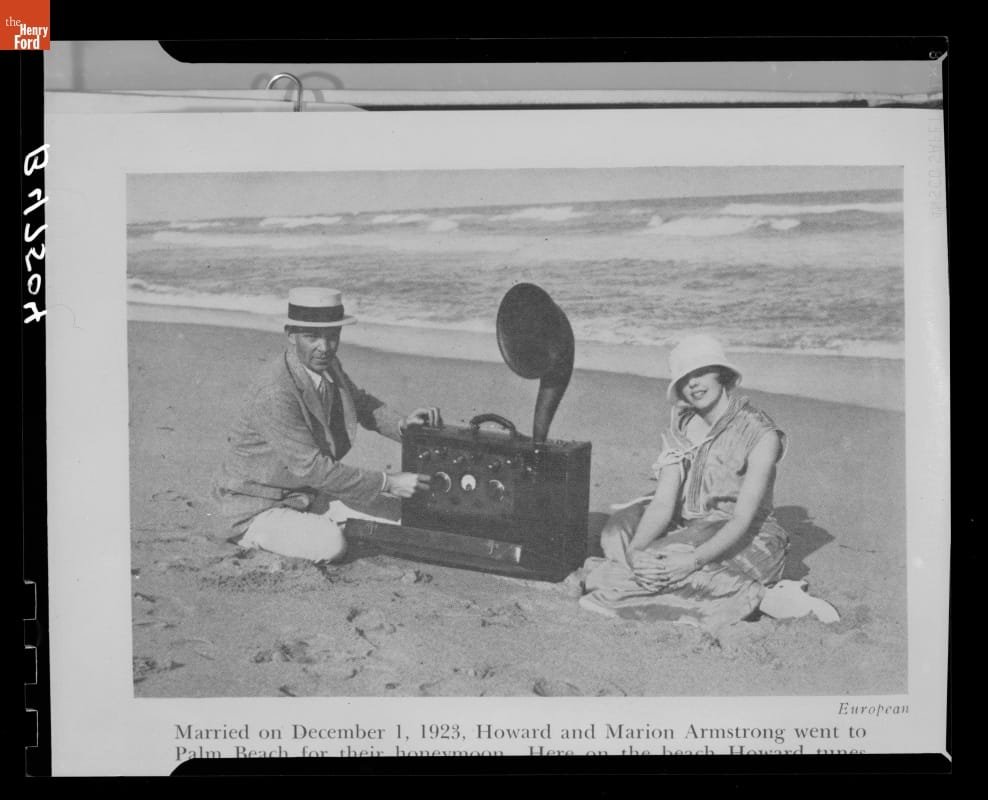
Edwin and Marion Armstrong, on the beach, 1923. THF 120661
Tunes for the Honeymoon
Not only was Armstrong an intrepid inventor, he was also a daredevil. His shy persona was a contrast to his bold innovations and daring publicity stunts. Before he married his wife Marion, he climbed to the top of the RCA tower in New York City to impress her. Apparently, it worked—because we soon see Marion and Armstrong on their honeymoon, sitting on the shore of Palm Beach in Florida. Armstrong built the portable radio in this image as wedding gift to Marion, and it is the same radio in the collections at The Henry Ford. 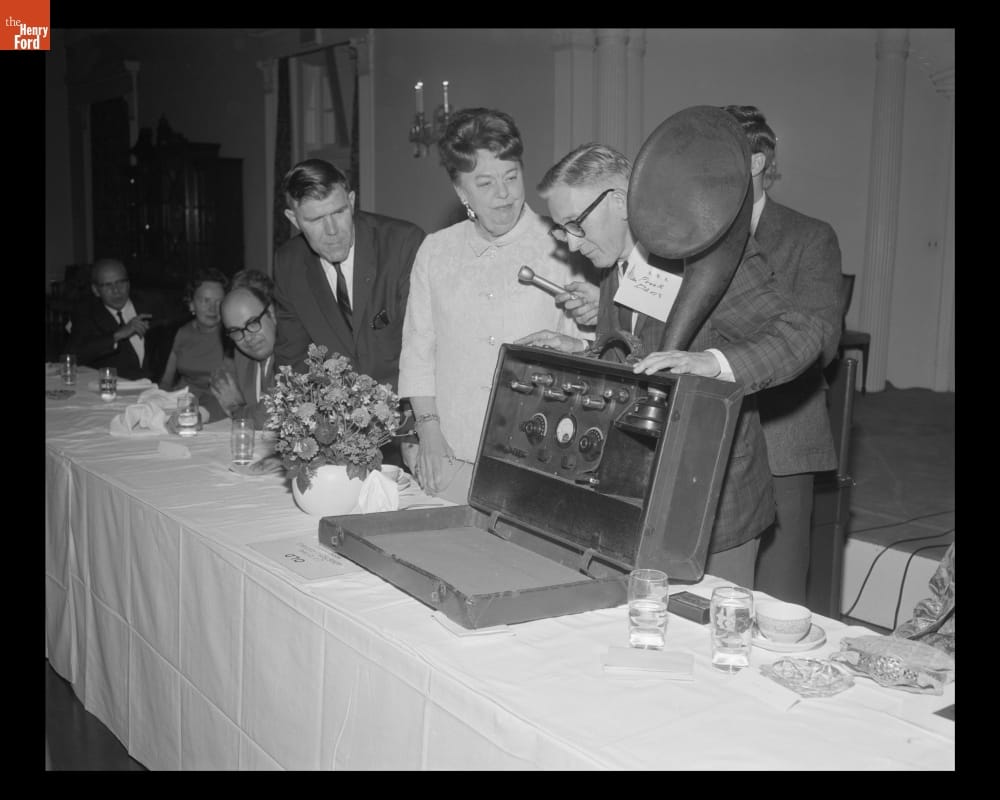
Marion Armstrong at The Henry Ford, 1967. THF 131774
Armstrong’s Legacy
Armstrong was well known in his own time, and was highly respected. His story is also tragic, because he spent decades of his career in legal battles over patents that other inventors raised against him. Even though he would receive credit for his contributions to radio, much of that vindication came after his 1954 death. In the image above, we see Marion Armstrong donating her husband’s radio to The Henry Ford in 1967.
Although today’s radio formats are shifting towards satellite and subscription services, if you’ve ever listened to a car radio where you a spin a dial to tune in to a station—you’re listening to Armstrong’s FM radio.
The sonic imprints of his legacy continue to bleed into our everyday lives: from voices on the airwaves, to entertainment on the road, to enlivening a relaxing walk with headphones—or a summery day with music at the beach.
Kristen Gallerneaux is Curator of Communications and Information Technology at The Henry Ford.
1920s, 20th century, technology, radio, portability, communication, by Kristen Gallerneaux
Connected Fashion
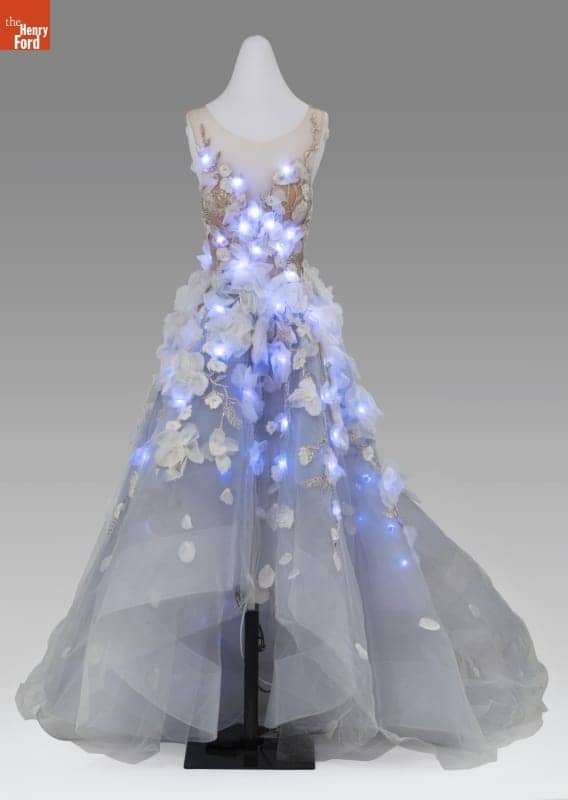
The Henry Ford is the now the permanent home for an object that sets a new standard in both communication technology and fashion - the IBM Cognitive Dress.
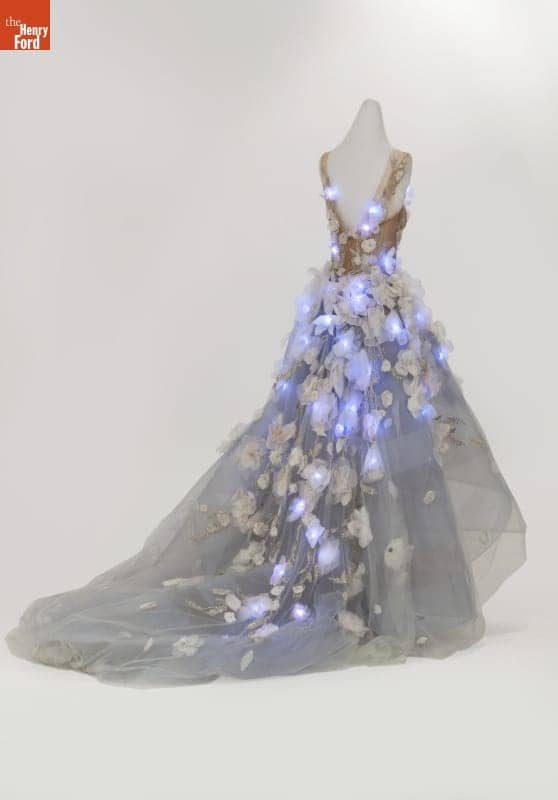
The dress originally debuted at the Metropolitan Museum of Art Gala in May 2016 as a stunning custom gown designed by high-end women’s fashion designers Marchesa with the assistance of IBM’s Watson cognitive system. The dress has many layers of collaboration and interactivity: the initial research between IBM and Marchesa, the ability for an audience to influence its color through social media, and the ability for the dress to then communicate and display the data result back to the audience.
So, how does it work?
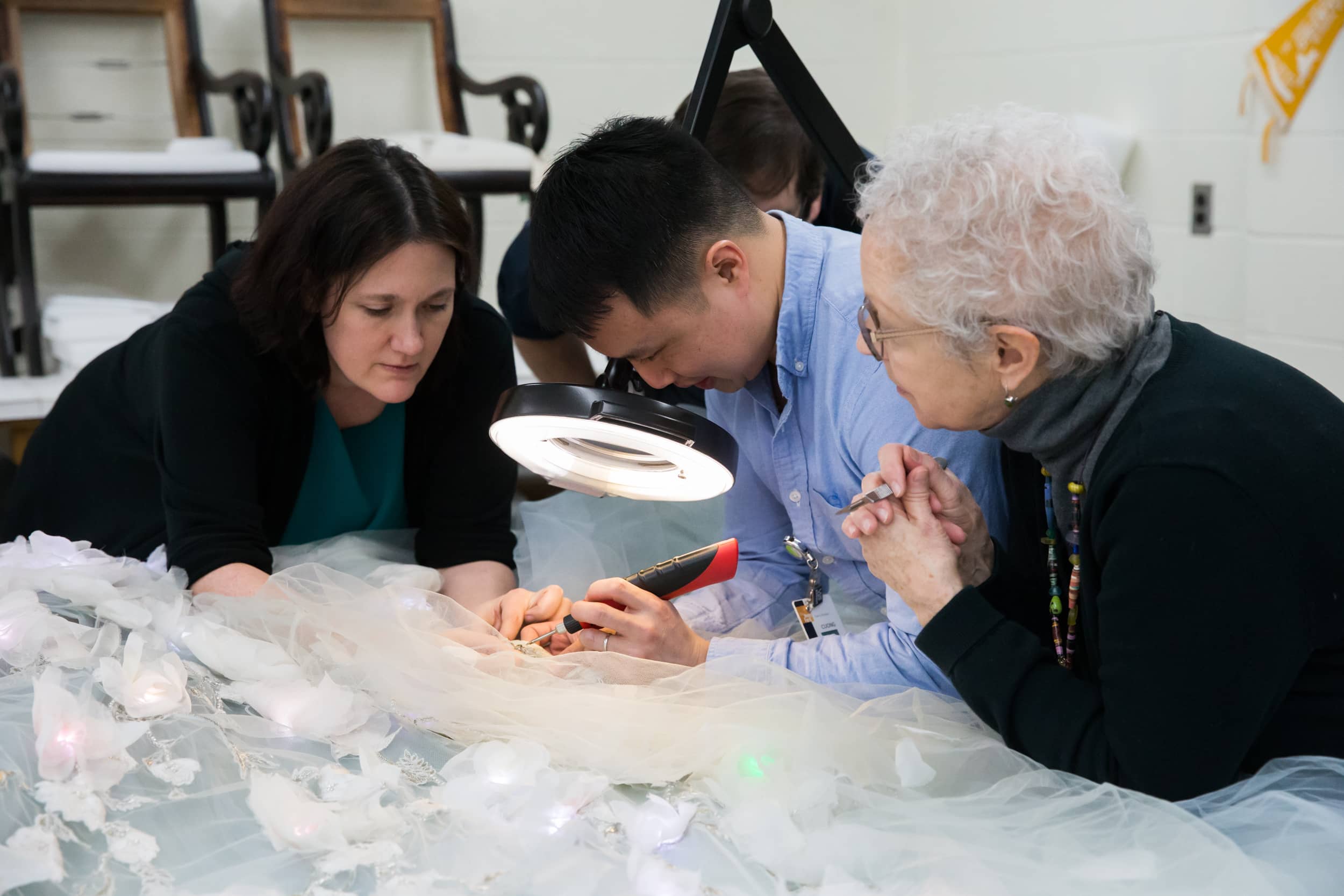
Watson is a cognitive technology--a form of computing that learns in a similar way to how humans learn. To make the dress interact with Watson, social media-responsive LEDs were sewn into its bodice and skirt. Utilizing Twitter and other social media feeds, Watson analyzes tweets and assigns an emotion based on the hashtags submitted, resulting in shifting color patterns across the garment’s materials.
The IBM Cognitive Dress is truly a smart design and a smart dress. The democratic appeal of social media has allowed the dress to become a significant part of today’s fashion industry. Fashion can now debut globally at an instantaneous rate--some companies go so far as to launch new collections using platforms like Twitter, Instagram, and Snapchat.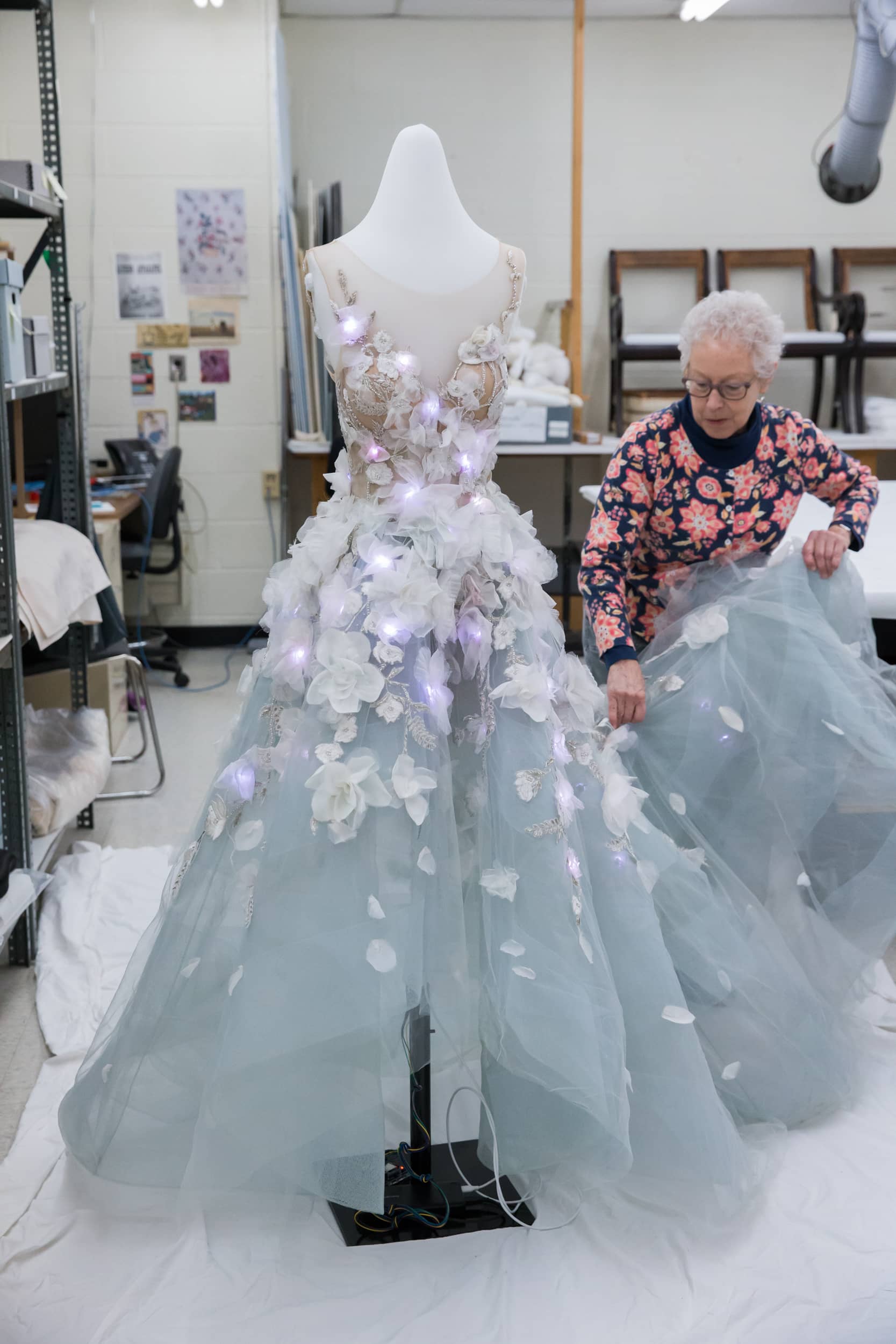
by Kristen Gallerneaux, lighting, fashion, computers, communication, technology, design

